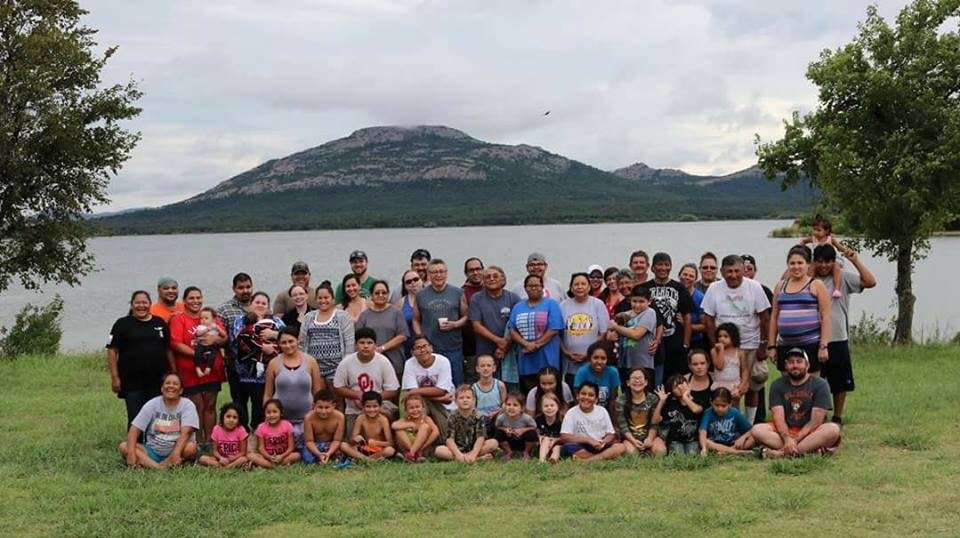
U.S. Southern Culture: Where are the Native American Authors?
Since Tahlequah, Oklahoma is only 30 miles from the Arkansas border, we relate mostly to U.S. Southern culture. Why do I mention my hometown? It's not only the place where I live, work, and raise my family. It's also home to two Cherokee tribal governments: Cherokee Nation and the United Keetoowah Band of Cherokees. I personally work for Cherokee Nation in the Indian Child Welfare Department. Additionally, the third Cherokee government is the Eastern Band of Cherokees in North Carolina. All this to say, Cherokees are the largest federally recognized tribe in the United States and our governments are historically situated in the South. So why don't we exist in the canon of Southern literature?
It looks like the American system has made us invisible once again. It amazes me how hard folks work to keep the "pristine myth" alive. While we are the smallest minority in the U.S., we are here. Don't believe the lies. The land is not vacant. There are Indigenous people here and we've been here since time immemorial. We drive the same highways you drive, and often climb the same ladders. So there's not a lack of Natives writing from the South. What's missing is the amount of attention we receive.
If I were to ask you, who is the quintessential Native American author from the South? Does anyone come to mind? Now don't go running to Google! That's cheating. I can name several contemporary Native American authors with Southern roots, but I have a Master's Degree in English with a concentration in Native American Literature from the University of Oklahoma. If I didn't readily know any names that'd be a problem. But most American readers don't know. Some might mention Joy Harjo because she was the U.S. Poet Laureate in recent years.
As far as fiction writers, there's Leanne Howe, Annette Saunooke Clapsaddle, and Kelli Jo Ford. There are also contemporary poets, like Sy Hoahwah and Santee Fraizer. Those are off the top of my head. More names will come to me later. Historically, there's no one with more publications than Robert J. Conley, who was not only an enrolled member of the Keetoowah Band of Cherokees but also wrote novel after novel about Cherokees in traditionally Southern environments. He not only wrote about Cherokee historical figures but also depicted the removal of Cherokees from North Carolina in his novel Mountain Windsong. While much of his writing was historical fiction, he won three Spur Awards in the Western genre. Conley was someone who should've received more recognition for his contributions to Southern literature. Maybe we could've honored him in the same way we honored Lee, Hurston, and Faulkner.
I'd like to commend the publishing industry for recognizing when there is a societal discrepancy, like lack of representation. In recent years there has been tremendous gains in this area. There are more BIPOC authors right now than there has ever been in American history. I'd also like to ask the publishing industry to consider the biggest issue facing Native Americans today: invisibility. We are the smallest minority in the U.S. with some of the highest disparity rates. Our communities are doing phenomenal work to end intergenerational trauma. Native people are resilient, hardworking, and proud. Give Southern Natives the opportunity to showcase our tenacity and strength. Recognize our contributions to the publishing industry. The canon of Southern literature needs Native voices--voices that not only advocate for tribally specific customs but can also represent historically targeted communities with a critical eye and genuine compassion.
Debut Novel 14 Years of Ups and Downs: How CALLING FOR A BLANKET DANCE Survived, Endured, and Finally Came to Being
I'm always drawn to these stories. Of the writer who wrote for decades to finally find her way onto a bookshelf. I'm drawn to them because I feel for what the writer has endured and the level of gratitude that comes along with it. It's rough out there. We're all tough. You can't endure the writing process without thickening your hide with a multitude of scars. There are many talented writers. When it all comes together, when your hard work finally meets opportunity, you can't help but find yourself in a gracious meditation on the trials and tribulations of creating your work of art.
I'd like to start this with an homage to the educators. You see back before my entrance into literary writing, I wanted to be the Native Stephen King but I was also growing further away from the horror genre. During this period in my late 20s, I luckily found myself accepted into the Institute of American Indian Arts (IAIA) in Santa Fe, New Mexico. This was where I delved deep into literary genre's themes around social justice. I also met my mentors, Evelina Zuni Lucero and Stephen Wall, at IAIA. Evelina was the Head of Creative Writing, and Stephen Wall was the Head of Indigenous Liberal Studies. Little did I know at the time that I'd walk away three years later holding a BFA in Creative Writing with a minor in Indigenous Liberal Arts. I'm indebted to Evelina and Stephen for the leadership, guidance, and willingness to mentor a stubborn and often egotistical young man.
It was during my time at IAIA that I developed the earliest chapters of my debut, CALLING FOR A BLANKET DANCE. I wrote a story titled, Got Per Cap?, in 2008 and this was where my Kiowa community voice came out. The story was later published in American Short Fiction as "Our Day," and then eventually I changed the title to "Our Dance." Now the story is the fifth chapter in the debut, which is titled "Quinton Quoetone (1993)." Soon after developing my Kiowa voice for the page, I then began developing my Cherokee voice, and this came to fruition the following year, 2009, when I wrote a story called "Time Like Masks." This story would eventually be published in South Dakota Review, and is now the third chapter in my debut, titled "Hayes Shade (1986)."
"Psychologically, I couldn't even slide a flash drive into my computer for the purposes of writing another story, chapter, novel."
~ Oscar Hokeah ~
It was the process of developing these two stories that began a life long effort to disrupt the perception of Native American peoples as being a single homogeneous group. Since I grew up between Kiowa and Cherokee communities in Oklahoma, I knew first hand about the similarities and beautiful differences between tribes. I also knew about the ugly contention between these two communities--slights, judgments, and stereotypes all. I felt like I could show readers in subtle and obvious ways how these dynamics play out. How we as Indigenous peoples share a common history of colonial violence, which pulls us together, and at the same time how each tribe has beautiful and unique qualities to be honored and cherished.
By the time I graduated from IAIA in 2009 and went on to the University of Oklahoma in 2010, I had my ego bruised enough times to be humbled by the creative writing process. There is no better way to condition yourself to humility than pouring yourself onto a page and receiving the harsh realities of what is and what isn't. In 2010, I had a sense of my direction as a writer. I was already calling myself a regionalist writer. In fact, I used the two stories mentioned above in my admissions paperwork to the University of Oklahoma (OU), and it was this very dynamic of seeking to disrupt the perception of Natives being a homogeneous group that had me accepted in the Master's Program.
It was at OU that I found my next mentor, Dr. Geary Hobson. I had entered the Master's Program under the Creative Writing program, but quickly found myself hitting a writer's block. This would begin years and years of self-doubt and self-criticism that would cripple my ability to write. While the two stories mentioned above were both published (both before I obtained a Master's Degree), I received harsh criticism that I felt was more of an attack on my drive to become a published author. One thing I've learned is that in writing programs we find our most cherished mentors, but we also find our most ambition detractors. For every person hoping for our success, there are a dozen others wishing for our failure. I quickly stopped writing. Psychologically, I couldn't even slide a flash drive into my computer for the purposes of writing another story, chapter, novel. I thought of myself as failure who didn't truly see his pathway to publication, and more of a delusional novice with perpetual misgivings. Eventually, I switched to a concentration in Native American Literature, and this is where I found Dr. Hobson. He was kind and considerate and took me under his wing, talking to me for long periods of time and sharing some of his secrets to staying in the creative writing space.
"Suddenly, the last strand weaved itself into place. I had figured it out. This was a decolonization narrative and the main character was healing through familial love and cultural grace."
~ Oscar Hokeah ~
It wasn't until after I graduated from OU in 2012 that I found myself writing again. It had been three years at this point. The stories I mentioned above were written in 2008 and 2009, and then I finally started to write again in 2012. I wrote the first draft of one story that would later be titled "Paper Towels." Slowly, I wrote a story here and a story there (all first drafts), and then I started to revise, slowly again, until I had a good collection together. By 2014, I had my first book and titled it: Reflections on the Water. The collection centered a male character who had similar traits as his mother. Basically it was a compare and contrast. I remember sending out queries to agents and they all came back rejected. But I kept going. I submitted some of the stories, like the one titled "Paper Towels," to literary magazines. Again, I received rejection after rejection. None of the stories were getting picked up, and the agents weren't responding to the collection of stories. Finally one agent responded and asked for 50 pages, but after I sent the 50 pages I never heard back again--not even to get a firm rejection. So I gave up again. It was pointless. Why was I writing? No one was interested.
One year and one divorce later, I found myself back in my hometown of Tahlequah, Oklahoma in 2015. Having just left a job that was spiritually grueling and traumatizing for reasons I'll not mention here, I decided I was going to write a novel about the experience. This one wasn't going to be a novel-in-stories like my last defeat. This one was going to be a full length novel about enduring the hardships at this specific place of work. I've mentioned this experience on previous posts, but my brand of writing is what folks might call "semi-autobiographical fiction." It's fiction, but it's closely drawn from my personal experiences or experiences of friends and family. I was taught "write what you know" at IAIA, and I took it to heart. So I spent the next year writing this novel. I wrote a complete first draft and then sat it aside in 2016.
Then I received an email from my old mentor, Dr. Hobson. He asked me what I was working on and I had mentioned the novel about my "workplace tribulations." But it was this simple and generous question that made me start thinking about the collection of stories that didn't quite make it. So two years later I decided to slide the flash drive into the computer and take a look at these stories again. I figured I had nothing to lose so I decided to tear it apart, to look for a different story line, to find a better angle. I discarded some stories and kept others. It was a little triggering. My self-doubt increased again, but I kept at it. I kept looking at the stories and searching for something that might work as a book. After months and months of stepping away from the stories and then opening them back up, I finally saw it. This wasn't a compare and contrast novel. It was a transformation narrative. The central figure wasn't a reflection of his mother, but instead he was an entire ecosystem--and this ecosystem was his family. I saw the thread where the main character was highly aggressive when he was younger and then eventually purged his aggression. So why did he transform? Suddenly, the last strand weaved itself into place. I had figured it out. This was a decolonization narrative and the main character was healing through familial love and cultural grace.
It was 2017 when I started writing new stories, started adding new characters, new family members, and the ecosystem just grew and grew. Soon I could see this one character from a multitude of angles because every family member had a different view point of his life. Literary fiction is character driven fiction. The greatest compliment a literary writer can get is that "these characters are real and alive!" With the chorus of stories, the main character was more alive than he had ever been. So it was somewhere in the middle of 2018 when I learned of #DVpit on Twitter. It was a pitch event for "diverse voices," and I decided I was going to give my new collection in stories a shot. For two months, I wrote and rewrote a tweet-sized pitch. Then the day of the #DVpit pitch event arrived, and I started to post...post and watch...watch and post. To my surprise, the one and only Beth Phelan retweeted my pitch with eye emojis. So five different agents clicked on my tweet. I couldn't believe it.
"I was a #DVpit success story."
~ Oscar Hokeah ~
Long story short, I signed with Allie Levick of Writers House. I was a #DVpit success story. It worked. I couldn't believe my luck, and my confidence shot through the roof. So when Allie came to me and said, "We're going to need to add about 30,000 more words," I didn't flinch. I said, "I can do it," and I completely believed in myself. And over the next few months I did exactly that. This was when Vincent Geimausaddle, Opbee Geimausaddle, and Araceli Chavez were born. I added new family members and strengthened the ecosystem that we all now know as Ever Geimausaddle. So Allie and I worked over 18 months tightening up the novel and getting it ready for publishers. It was now late 2019 and we came to the final moments of revision. Then early 2020 came and we started pitching to publishers. And we all remember what happened in early 2020: COVID. So the exact same time Covid hit the United States and shut everything down, I negotiated terms with my publisher, Algonquin Books. Later that summer the contracts were signed. It was official. I was going to be a published author.
Now the story doesn't stop there. As all those published writers know: there is the process of revision with the editor. I started working with Kathy Pories and she did a phenomenal job of slicing and dicing. She knew exactly what to say to get me to take the novel to the next level. It was motivating. She asked me to cut certain things that made the novel exactly what I was hoping it'd become. Her talent for seeing the true essence of a story is amazing. Sometimes it's just rearranging small dynamics and cutting the tiniest pieces that brings a character to an even brighter spirit. By time Kathy and I were finished, we had transformed a novel-in-stories into a full length novel. It was awesome to see and a great learning opportunity. I can say with absolute certainty that I'm a better writer for working with Kathy. I'll be forever in her debt.
So it was the end of 2021 and Kathy and I finished with the last of the last copy edits. Finally, the book was complete and fully packaged and ready to go. Now, it was time for getting the word out. Writing is the hard part and it was long and arduous, but we can't underestimate the value of marketing. Next, I began reworking a pitch that I thought I had a handle on. I soon realized that every time I was asked the dreaded question, "So what's your book about?," I had a different response. I didn't know why. Through the events put together by the marketing team, I was given the space to work and rework a succinct pitch. I've had to learn what to say at the beginning of my response to get my brain to funnel toward the center of the novel. What I've learned is that there is always refining to do, and all this refinement started 14 years ago. My debut, CALLING FOR A BLANKET DANCE, landed on bookshelves on July 26, 2022. And it's been a whole other learning experience in my debut year. So stay tight to my blog, and sometime in the not-so-distant-future I'll recount the trials and tribulations of my book's first year in the world.
Why I Vanished from Social Media
I wish I could say there was only one reason. But there was definitely a primary reason. The last two months have been a little rough for my family. My little sister had a major stroke. For those of you who've had a loved one go through this you'll understand perfectly what I mean. It's sudden, unexpected, and unfortunately my sister didn't make it to the hospital in time to get the medication that would have saved her from the more severe damage. So there we were: a family in turmoil having to make major decisions regarding my sister's life.
Truly, social media had become habitual chaos. Posting, commenting, liking, sharing across four--sometimes five--platforms can be a lot. When real life happens, suddenly it can appear to be a little absurd. With the challenges of new circumstances, clicking on a social media icon was too difficult. My little sister's life was forever altered, and there was a window when we weren't sure if she would survive. So eventually, I went onto all my social media sites and just deleted them. One after the other and in a matter of a seconds they were all gone. And there was something empowering about that moment. I knew what mattered most and I was going to give it my full attention.
There was a part of me that felt a little guilty. I had released my debut novel in late July and had been plugging away on social media to promote the book. I met many great folks. Sometimes I wished I had that back again. The playful comments and genuine connections. There are a ton of kind and generous people out there. Right now my days are filled with juggling my kids' needs, helping with my little sister, and continuing to serve in Indian Child Welfare. We just finished Cherokee Nation's Angel Project where we gave Christmas gifts to 2,800 Cherokee children in need. We made Christmas a little brighter for some of our most impoverished citizens. I also got to spend quality time with my daughters, and worked with my little sister to help her speak again. It's been busy and trying in profound ways.
I'm grateful, and I've been good about being grateful, but maybe I'm a little more grateful these days. Maybe sometime in the future I'll start my social media back up again. If a new normal ever sets in. For the time being, I'll be posting here on my blog. It's much more straight forward and easy to engage with. Right now I need to keep my life simple to get through.
In Defense of Peripheral Narration: Fitzgerald Vs Hokeah in a Battle of Class, POV, and Power
Have you heard of a book called The Great Gatsby? It's written by F. Scott Fitzgerald. Most folks read it in high school. I didn't make it to high school (the last grade I completed was the sixth grade) so I didn't read it until I was an adult (after I went on to obtain a Master's Degree). If you remember, the novel is told by a character, Nick Carraway, about another character, Jay Gatsby. The reason I'm bringing up this particular book is two fold: (1) It's well known, and (2) it's a popular example of peripheral narration, where one character tells the story of another character. Don't worry this is not a rehearsal of Fitzgerald's novel. Instead it's an allusion to mine.
If I were to make a comparison between The Great Gatsby and my debut novel, Calling for a Blanket Dance, I'd argue it takes peripheral narration and amplifies it. Why? I enhance it with polyvocality. Both books are short reads that pack a big punch, yes. But we, Fitzgerald and I, operate from opposite ends of the class spectrum. As you probably know, The Great Gatsby is about the wealthy and critiques the American Dream by showcasing the underbelly of the uber-rich, where Calling for a Blanket Dance is an homage to the working class, who aren't trying to stratify a system but simply want to live without becoming victims to a movable standard. The Great Gatsby is to the wealthy what Calling for a Blanket Dance is to the working poor.
“There are only the pursued, the pursuing, the busy and the tired.” ― F. Scott Fitzgerald,The Great Gatsby
All that aside, let's think about the periphery. If we were in a creative writing class, I'd probably give you reasons why an author, such as myself and "old boy" Fitzgerald, would employ it as a technique. These reasons tend to be somewhat obvious, like the main character might have a secret, she or he might die during the course of the novel, they could be unlikable and therefore not relatable, and/or each story might be more important to the narrator(s) than it is to the main character. But this is not a creative writing class so I'll not go on about those.
What I will address is the richness of peripheral narration when doubly executed with polyvocality. What happens when 11 different people tell a story about you? If they were coworkers, we'd probably get the down and dirty about your shady-ass past and how you're not as angelic as you might think you are. If it's your family, then we'll get something a little more diverse, a little softness to go along with the prickly. Bittersweet, if you will. And I'll argue here that we'd get more depth about you as a person from your family than we would from you. Using peripheral narration mixed with polyvocality gives readers a much richer and deeper understanding of a main character.
“Let us learn to show our friendship for a man when he is alive and not after he is dead.” ― F. Scott Fitzgerald, The Great Gatsby
Ultimately, it gives us more than the typical drama triangle (villain, victim, hero). Instead we move away from Western traditions in literature and step a little closer toward Indigenous ideology, like shaping an entire novel on traditional Kiowa and Comanche customs (say a Blanket Dance, maybe). Here the community has agency--not the individual--where a collective center from a tribally specific and historically targeted community wrap around each other in support, healing, and decolonization. Where we acknowledge how we are shaped by the people who love us the hardest. Moreover, where a chorus of voices sing in rhythm with a single thundering drum, reverberating out and across the planet to announce: our power is back.
"Stunning" Novel Cover: Symbolic Representations in Post-Modern Art Forms
There are two questions I love most when it comes to talking about my debut novel. One has to do with the structure, with it's polyvocality laid atop time jumps spanning three decades, and the other has to do with the cover. It's a striking image. An image that conveys perfectly the post-modern fracture experienced by the main character, Ever Geimausaddle, and his resilient trek through the process of decolonization.
There are so many layers to this cover, but before I jump into the nitty gritty I'd like to take a moment to talk about the initial reaction to the image. Covers are designed to do one thing more than anything else: Grab the reader. It's supposed to get a reader's attention so that they'll want to further examine the contents. My hat goes off to Christopher Moisan, who is the Creative Director at Algonquin Books. He did an amazing job creating such a wonderful design. I'll discuss here in a moment about how each layer of the image speaks so clearly to the novel. I wanted to acknowledge first how striking the image is and how perfectly it grabs the eye.
Christopher suggested using the artist who created the image, Christin Apodaca. She had been on his radar for a while and he thought her post-modern style matched perfectly with the post-modern aspects of my brand of literary fiction. She is from El Paso, Texas and representative of Latinx communities. I'm half Mexican, with my father being from Aldama, Chihuahua, Mexico, so it was important to work with Hispanic artists from communities of color. And I can't say enough how important it is to support women artists in a field dominated by men. Christin's murals can be found at different locations in the city of El Paso, TX. You can also discover her art here: http://www.capodaca.com/.
Christopher took the power of Christin's image and enhanced it with deeper symbols. The image itself is ripe with symbolic representation. In black and white alone, the dollar bill and sash sends my mind toward Kiowa and Comanche gourd dances. Those of us who engage in traditional gourd dances know that a crumpled dollar bill dropped at the feet of a dancer signifies a process of honoring. I immediately connected how the main character, Ever Geimausaddle, is trying to live with honor. With the sash coming down, I knew this honor was inextricably tied to his family and his community. Christin did a superb job of picking up on those very important symbols in the novel. I can't even imagine the arduous task of reading someone's novel and then coming up with a visual representation of the novel's theme. Christin did exactly that, and she did so with the exquisite detail of her personal style, which I describe as a post-modern Salvador Dali style. And it matched perfectly with the post-modern structure of the novel.
Then we get the brilliance of Christopher Moisan at work. So how does a Creative Director go from this amazing sketch to a final product that will grab a reader's attention? I asked for the image to be made into color and Christopher was on the same page. I let him know to make the sash half red and half navy blue. These are the colors that Kiowa and Comanche dancers wear. I asked for him to place the red on top to signify that the main character, Ever Geimausaddle, is Kiowa. If it were navy blue on top then it would signify Comanche. While Christopher couldn't make the blue a navy blue because it would've printed too dark on paper and wouldn't have looked blue at all. Moreover, it would've erased all of Christin's beautiful line work. So Christopher went with a royal blue with dark line work. I understood his reasoning. It's not only how the colors come out in a jpeg, but also how it prints on paper. Once he filled the image with color not only did the sash pop but the dollar bill as well.
Now the image was an accurate depiction of what I grew up seeing at the gourd dances. I'm a gourd dancer myself. My family (Hokeah/Tashequah) has organized gourd dances for decades on the Southern Plains of Oklahoma. We're tied into some of the oldest Kiowa and Comanche Societies, such as the Kiowa Tia-Piah, Comanche War Scouts, and Comanche Little Ponies.
So I'll be honest here. I gave Christopher a hard time, or maybe I was just a little picky. I hope I wasn't too much of a pain. I wanted to get the colors right. When the ARCs printed, the image came out a little too artificial, I thought. I asked Christopher if the final book was going to do the same. He assured us that he had immediately contacted the printer and discussed the issue. I felt like a bit of a diva. I didn't want any part of the image to come off as artificial, and Christopher was a saint. I'm extremely grateful to have this opportunity to showcase my writing. I feel very fortunate to be in this position. I hope I wasn't too much of a nag. I felt like I kept asking for tweaks here and there. Subtle requests that may have been too often. But I'm grateful Christopher was willing to hear me out and modify at each stage.
What truly made the image resonate for me was the overall design. Christopher came back with a couple background settings. When I saw that pattern atop the orange, I immediately thought of the main character's grandmother, Lena Stopp. Just to explain the brilliant mind of an amazing Creative Director, let me tell you how deep this image goes. Notice the grid. The subtle squares in the background behind Christin's image. The bold orange background beneath red squared patterns, with those splashes of yellow. It's one of Lena's quilts! Now you're about to say I'm giving away a spoiler. You're asking, "Lena makes quilts in the novel?" She does, but this is divulged in the first chapter. You can read the first chapter via Buzz Books through Publishers Marketplace. So I'm not giving away any spoilers that aren't found in the first chapter.
What makes this so special is how Christopher turned the cover into a representation of a bird. Why is that important? As you read the first chapter, you learn that Lena Stopp makes grandchild quilts. On those quilts, she places images of birds. She does so because her family belongs to the Bird Clan in the Cherokee tribe. She uses the quilts as a way to keep her family connected to each other. I got the idea from my own mother, Virgilene Hokeah. My mother makes grandchild quilts for all her grandchildren. They all have the exact same pattern, but each quilt is made of a different color scheme. It captures her grandchildren's uniqueness and their ties to her, simultaneously. Similarly, Lena Stopp uses bird symbols to represent the Bird Clan so her grandchildren will know they are connected to the Cherokee community.
Understanding how to work with artists is an amazing talent. Christopher was able to take Christin's sketch and read my novel and come up with a way to capture the heart of the main character, Ever Geimausaddle. There's an important detail with Lena's quilts that I'll not be able to mention here. It comes in the final chapter of the novel. I'll have to let you discover that element yourself. But I would like to say is how much thought and care went into this cover. While it certainly does its job of grabbing someone's attention, it also speaks to a team of brilliant minds who think beyond simple surface qualities, who can see concepts behind imagery, and has the capacity to dream big and reach deep into the emotional center of a story.
Vernacular, Agency, & Intersectionality of Language Transformation
Growing up in households where words and phrases in both Kiowa and Cherokee were spoken and mixed with English, it gave me a unique understanding of language. As my family spoke, someone could be both skaw-stee and mon'sape. Skaw-stee is a Cherokee word that means "stuck up," and mon'sape is a Kiowa word that means "trouble maker." Mix these words with other phrases and Indigenized English words like gaa which is the Native version of "golly," and all of a sudden language becomes a playground of agency. Where this Kiowa/Cherokee/Mexican boy had a canvas of words to create a beautiful new symmetry.
When I arrived at the University of Oklahoma for the Master's program in English, I had already written one of my earliest pieces where Kiowa and Cherokee communities intersected. I became even more fascinated by colloquial vernacular and the waves it could create in literature. It made sense to me. Of course community members had the freedom to use language in a way that made sense to them. Each community, whether tribal or not, had its own terms and sayings and accents and ways of engaging, and every community had the freedom to make of language what it wanted.
While I was learning to be a grammarian, I also learned how to break those rules exquisitely on the page. For me, it was an act of rebellion. I was going to exercise my agency and use language the way it was used in the households where I grew up and had access to. As a child, I could be at a traditional Gourd Dance and hear Kiowa and Comanche and then later in the same summer be at traditional Stomp Dances and hear Cherokee or Creek. Then there were times when I'd be with my cousins in Aldama, Chihuahua, Mexico and hear streams of Spanish. I shifted between these cultures fluidly, and all these languages were normalized as they landed on my ear. I didn't think it odd or unique. This was my life and it was just the way things were.
Fast forward a few decades and I'm in a classroom at the Institute of American Indian Arts in Santa Fe, New Mexico. I'm buying into the doctrine of "literary fiction," where we bear witness to our experiences, where we bleed on the page, where we tell on ourselves before we tell on anyone else. And as I'm writing as catharsis, seeking to heal deep traumas from childhood, I'm also aiming to capture my communities and my families the way I had truly experienced them. Not some generic version of Native identity that makes white people feel safe enough to consider us "model minorities," in some type of sad display of pitiful. But Natives who were sometimes mean and vicious and were amazingly cruel heroes. Blur the lines between hero and villain--make characters so human that readers think they're real.
And in all that, I had to be honest about the intersectionality of language and how language itself is "real" and "living." I knew I wasn't only going to capture character with genuine authenticity, but I needed language to lay on the page the way it lays on the lips of children--with direct honesty. This is what I heard. This is what I said. This is the way we were--and still remain. So when you engage my debut novel be prepared for language and rhythm to disrupt your senses. You think you know Native peoples, but you only know a Native people, and are about to learn what it means to be Indigenous in a Neo-modern intertribal world, where Turtle Island is the only map to show you the way.
Intro to Literary Fiction: A Native American Writer's Reasoning Toward Episodic Novel Writing & Unfamiliar Terms in Familiar Terrain
"What do you write?" Have you heard that question before? For literary writers this question is like a grain of dirt on the ass cheek of a wild hog running through the brush in the Ozark Hills. Every time I go to answer the question I know what's going to follow. It's going to be another question, with a quizzical expression on the questioner's face, asking me, "What's literary fiction?"

I wish I could say, "Literary Fiction," and folks would go, "Okay, that's cool," and then we could both go our separate ways. But that's never happened, and likely never will. In recent years, I've heard the term "adult fiction" being used more often. Maybe it's because we get less confusion and less hassle so we've started to lean on it. It's kinda like when I call to-go from a restaurant and the person on the other end of the phone doesn't hear my name right. I'll say, "Oscar" and they'll say back, "Austin?" I'll do this three times and then give up, saying, "Yes, Austin." At some point, literary writers get tired of trying to explain ourselves.
I've also started to name writers and for the most part I'll say Louise Erdrich, but I've also said Toni Morrison's name, to give folks a reference point--in search of someone they may have heard of. Typically, I name writers who have won the Pulitzer Prize or the Nobel. But the average person on the street doesn't follow those lists so often I'm left without a quick reference.
I've searched on the internet. There's "serious fiction," but I think that's more confusing than literary fiction. Adult fiction makes sense. It's a little more to the point, but most genres could be considered adult fiction. While literary fiction fills the shelves in bookstores for some reason there is little to no clarity on the genre. How can such a popular form of fiction have such a vague understanding?
"However, we should not be judged by our lowest common denominators. And also you should not fall prey to the fallacious thinking that literary fiction is literary and all other genres are genre. Literary fiction is a genre, and I will fight to the death anyone who denies this very self-evident truth." --Patrick Rothfuss
Then there's the response I get from writers of other genres. Some folks think literary fiction writers are stuck up and look down on genre, which couldn't be further from the truth. I love genre fiction and read across several genres like horror, fantasy, and noir. I think literary writers tend to be more serious in our personalities and that might come off as being disinterested. I can only speak for myself so I'll say that I am a serious person and I tend to be drawn to more serious issues. There's a part of me that feels obligated to attempt to fix societal issues, like I need to do my part to make life better for people of color. But in no way do I think genre fiction is less than literary fiction. If not for genre fiction I wouldn't have fallen in love with writing in the first place.
So I've come up with a description of literary fiction. Just to appease myself and my frustration in the pursuit of an explanation. Here it is: "An introspective study of the human condition that explores sociopolitical issues. More serious than genre fiction, it purposefully blurs the lines between hero and villain to focus on character driven plot. In addition, it seeks to disrupt formulaic writing."
It's long. I can't say this to someone on the street. But it knocks the dirt off the wild hog's ass, so I'm gonna keep it. I think people need to understand what they're getting into before they start reading a novel. My debut, CALLING FOR A BLANKET DANCE, is about Native communities, culture, and identity, but it's also about how Indigenous families confront toxic behavior. It's about the conflict between Indigenous matriarchy and Western patriarchy. What happens when these two ideologies clash? The main character, Ever Geimausaddle, becomes a battle ground. He's caught between two contending forces and he must make a choice. And if he does transform, what will it look like? The only way I could do this story justice was to wrap it in the genre I hold dear: Literary Fiction.

The Revival of Juxtaposition & the Reveal of Thematics
When we pick up any literary novel we must commit to being an active reader. We can be entertained by the surface plot and the triangulation between characters, certainly. But the purpose of literary fiction is to dive deeper into the text and search for symbols. Not only the symbols that comprise a larger thematic in a storyline, but, more importantly, the symbols that shape the really real world we walk through every day.
We can all make a case for engaging in a storyline passively. Sometimes we need to veg out on our favorite television show after a long day of hard work. Or we can reread one of our favorite books from one of our favorite authors. We know what's coming. It's not going to surprise us, and in fact we're looking for those predictable forms of entertainment as a way to escape our every day grind.
Then there comes those who are students of the game. Sometimes life gets a little too predictable and we need nourishment and intellectual stimulation. This is where literary fiction shines. Writers like Louise Erdrich, Toni Morrison, Alice Munro, and the like can entice us with intriguing worlds through beautiful sentences. And the deeper we look at their work, searching for the images and characters that represent something greater, we can discover insights into the human condition that make us into better people. Our empathy skills increase and we can better navigate social situations, with the hopes of creating a more just world.
When I think back on some of my favorite literary novels, I'm always remembering characters weighed against other characters, like in Louise Erdrich's novel The Roundhouse, where the treatment of Geraldine Coutts becomes even more profound as we learn more about Sonja. Equally, how Gabriel Garcia Marquez's novel One Hundred Years of Solitude exposes a new layer to humanity with each generation of the Buendia family. So when we exercise the power of juxtaposition, the multiple layers expose a greater truth. And often this truth gives us a hard look in the mirror, forcing us to self examine our own contributions to societal ills.
Ultimately, the reason I'm discussing juxtaposition today has to do with dynamics in my own writing. I'm brainstorming book 5 right now and searching for more details as the story concept floats around in the back of my mind. Also, much of my fiction, which is literary fiction, is developed through a variety of devices--one being juxtaposition--and I can't help but think of how each character weighs against the others.
"I'm always trying to find 'connections' between things. That art is the juxtaposition of a lot of things that seem unrelated but add up to something recognizable." - Pat Metheny
This dynamic plays out with much intentionality in my debut novel, Calling for a Blanket Dance. The novel is told by 12 different narrators with the purpose of juxtaposing each. Moreover, how each narrator compares and contrasts to the main character, Ever Geimausaddle. In fact, the thematics of the novel can only be discovered by juxtaposition. So much so, in the final critical moment of the novel, the reader must ask themselves: how would each of the previous 11 narrators act in this moment? Would they have done what Ever did in the final scene? I'm keeping these questions ambiguous right now because the novel doesn't release until July 26, 2022. I'll do my best here to not give away any spoilers. But it's the power of juxtaposition that offers the novel its greatest impact.
A longtime effort of mine, which is also showcased in the debut, is to disrupt the perception of Native Americans being a single homogenous group. Each tribe has beautiful differences, and we are drawn together under a shared colonial history. It's the power of juxtaposition that gives me the ability to show this tribal diversity on the page. The main character, like myself, belongs to two different tribes: Kiowa and Cherokee. I'm able to compare and contrast Cherokee communities with Kiowa communities. The first chapter is narrated by Lena Stopp, who is Cherokee, and then the second chapter is narrated by Vincent Geimausaddle, who is Kiowa. Each chapter moves back and forth between Kiowa and Cherokee community members so the reader can see those beautiful differences. Oklahoma has 39 different tribes and those of us who grew up here know these differences well, but if you're not consistently in our circles it can be difficult to distinguish. Juxtaposition gives me the opportunity to show readers a side of the Native American world they may have not yet considered.
“Creativity is that marvelous capacity to grasp mutually distinct realities and draw a spark from their juxtaposition.” ― Max Ernst
I only have time here to touch the surface of how juxtaposition plays out in my debut. As you come to know the characters, you'll see why Sissy narrates Lonnie's story and then how Lonnie and Leander compare and contrast. Moreover, how Ever Geimausaddle compares to his grandfather, Vincent. Does Ever pick up where Vincent left off? What does Ever do differently? How does this choice alter Ever's life? I could go on and on. The debut is so rich with juxtaposition, like Opbee and Lena, Turtle and Lila, Quinton and Ever (Sun Boy Split in Half). And it's only enhanced by the cultural elements throughout the novel. There is so much to discuss that I could go on and on for hours if not pages, and I hope you pick up a copy of Calling for a Blanket Dance so we can talk about these amazing details. I'm looking forward to the rich discussions this novel will generate.
Lately, I've found myself thinking a lot about the power of juxtaposition and how much we need to exercise this muscle as readers. It gives us the opportunity to view another person's hardships with empathy, but it also creates a much richer existence, where our quality of life is enhanced by a simple task: compare and contrast. And when we do so with purpose and intent, we can better see the world through someone else's eyes.
(Images were borrowed from Flickr)
Highly Anticipated Debut Novel in 2022 from Native American Author
So I know it's not cool to say "own voice writer" anymore these days, but we have to give credit to the Native writers writing from inside our own tribal communities. It doesn't happen as often as you might think. And you know what happens even less? When a debut Native writer from inside his tribally specific and historically targeted community gets a little recognition.
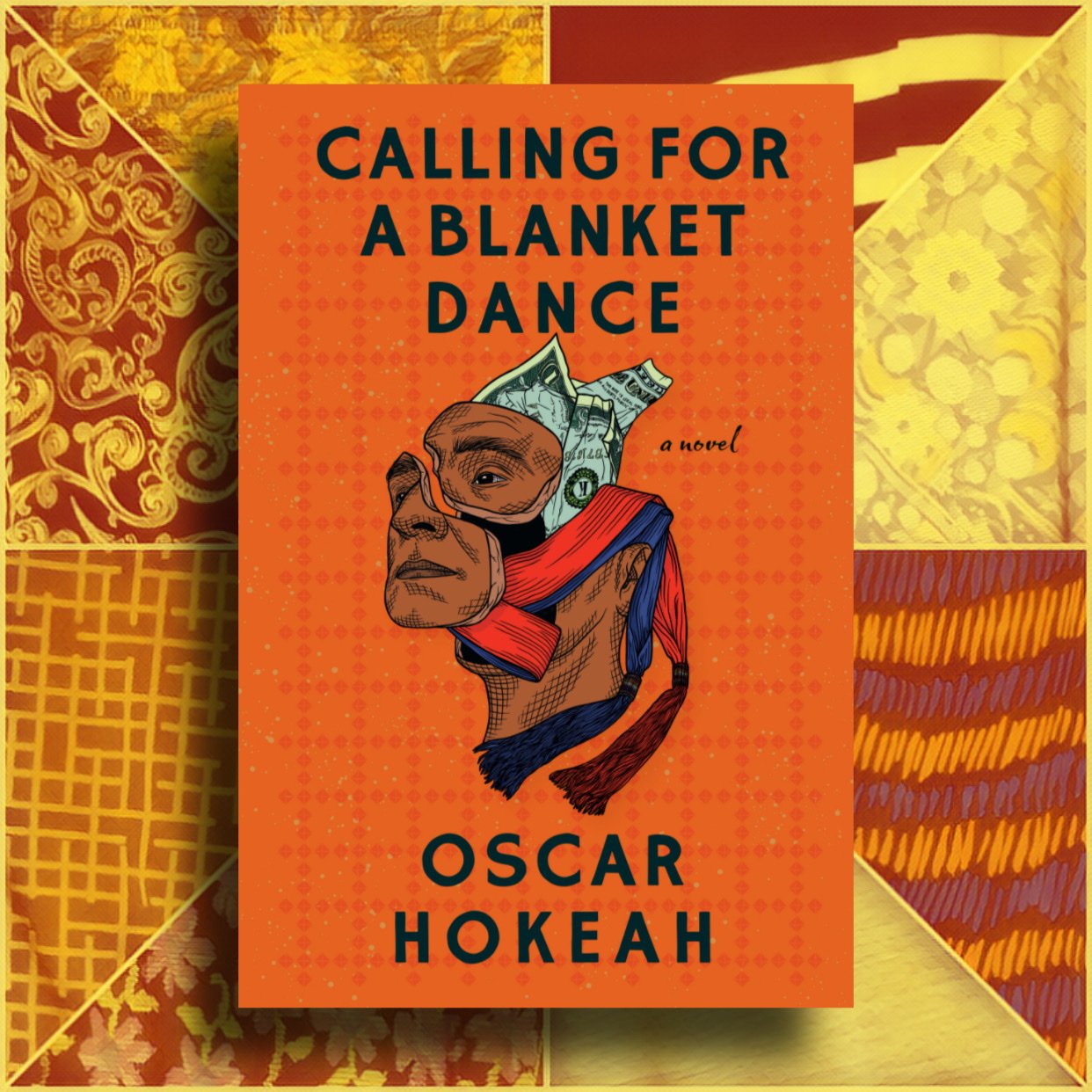
It's not easy writing about yourself. It's awkward. It can come off as egotistical. The shameless self promotion. I apologize, truly, for any of those vibes that may come out of this post. Honestly, it can be rough waters out there for any debut author, and we try to find small ways to get our novels into the hands of would-be fans.
Plus, we work years and years, toiling over words and living deep inside our imaginations to bring readers a vivid, entertaining, and sometimes eyeopening story. My debut novel, CALLING FOR A BLANKET DANCE, has been 14 years in the making. The earliest chapter was written back in 2008, and the debut will hit shelves on July 26, 2022. That's a long journey. We work hard on these projects and are eager to find readers to entertain.
Then we have good news to share and want to tell anyone who's willing to listen. That's part of the reason I'm writing this post. The debut has been honored with "most anticipated" and "highly anticipated" or "key debut" and I'm excited to share the wonderful news. Check out the list below:
- Library Journal (Key Literary Debut 2022)
- Goodreads (Highly Anticipated Debut 2022)
- Buzz Books by Publishers Lunch (Buzz Worthy Book 2022)
- Book Page (Most Anticipated Fiction 2022)
- Bookshop (Most Anticipated Book 2022)
- Bookish by NetGalley (Highly Anticipated Book 2022)
- Changing Hands Bookstore (Most Anticipated Book 2022)
Now if you'll let me share with you a description of the novel:
A moving and deeply engaging debut novel about a young Native American man finding strength in his familial identity, from a stellar new voice in fiction.
Told in a series of voices, Calling for a Blanket Dance takes us into the life of Ever Geimausaddle through the multigenerational perspectives of his family as they face myriad obstacles. His father’s injury at the hands of corrupt police, his mother's struggle to hold on to her job and care for her husband, the constant resettlement of the family, and the legacy of centuries of injustice all intensify Ever’s bottled-up rage. Meanwhile, all of Ever’s relatives have ideas about who he is and who he should be. His Cherokee grandmother urges the family to move across Oklahoma to find security; his grandfather hopes to reunite him with his heritage through traditional gourd dances; his Kiowa cousin reminds him that he’s connected to an ancestral past. And once an adult, Ever must take the strength given to him by his relatives to save not only himself but also the next generation of family.
How will this young man visualize a place for himself when the world hasn’t given him a place to start with? Honest, heartbreaking, and ultimately uplifting, Calling for a Blanket Dance is the story of how Ever Geimausaddle found his way to home.
If my debut sounds like something you'd like to check out, please reach out to your local bookstore and ask them to carry copies of CALLING FOR A BLANKET DANCE. You can also preorder at your favorite online retailer:
- Bookshop
- Barnes & Noble
- Amazon
- Target
- Walmart
- Books-A-Million
- IndieBound
- BulkBookstore
- Indigo (Canada)
To learn more about who I am and where I come from, feel free to peruse my website, read a few blog posts, and check out my social media. I'm most active on Twitter, but I'm trying to find more time on Instagram. I've recently made a TikTok but I'm still learning the ropes (so I apologize if my TikToks are a little crude).
Thank you for hearing out a nothing-little-Native from small-town Oklahoma. I hope you get a chance to read my debut and dive into Ever Geimausaddle's eclectic world. If you have a moment, drop a line in the comments below. I'm always happy to answer any questions and talk shop.
Native Heroes for Character Building: Issues with Villains and Victims in Storytelling
"Did you hear about Kaleb Nowater? Maybe his name was Kevin. I'm not sure, but it was a K name for certain. Come to find out, he was sexually assaulted by a worker at that children's group home. By whom? It was ol' what's his face. I forget, but he likes to surround himself with those wannabe artists. Anyway, they fired him because they caught him sleeping during overnight shifts in that poor boy's room. Awful. And imagine all those artists who just look the other way. I wonder if they know. More so, I wonder if they care more about their reputation than a child getting harmed. Just makes me sick to my stomach thinking about it. Who makes sexual advances on a teenage boy with emotional and psychological issues?"

So the above paragraph does a lot of interesting things. I'll not breakdown all the elements here. What I'd like to focus on is the dynamic between "the child with the K name" and "ol' what's his face." The victim and the villain. Immediately, we get caught up in the drama of the situation. It's intense. Someone is manipulating vulnerable teenage boys for sex. Our protective senses kick in and it makes us want to reach into the story to protect the victim. So this is perfect. This is exactly what writers want to do with a narrative.
But is this sustainable? Can we go on for page after page with this victim and villain pattern? Now what if I said the pedophile was Cherokee and the victim was Creek? Now we are instantly shinning a spotlight onto entire communities of color. And communities of color from the smallest minority in America. We can't overlook this dynamic because the stories we release into the world have real implications. People respond. People are affected. Lives can be altered. Legacy's can be ruined. And in an instant.
For some reason, I keep crossing Native characters being perpetuated as extreme victims or extreme villains. Now we're immediately drawn to the language in the first paragraph because it resembles how we talk amongst each other in our own communities. This is how we protect our children. Unfortunately, convicting someone of a sexual crime on a child is incredibly hard to do. So what do we as heroes do? We protect our families. We tell each other who is doing what so that families will keep their children away from predators, so employers will know who not to hire. With the initial language above, our protective factors jump in and our interest heightens.
Not only does the narrative implicate the villain, but it also implicates an entire group of people. A cult, if you will. It alludes to a cover up, or at minimum people looking the other way. And if we place this in the context of Cherokee people, the villainy suddenly paints the entire community in a certain light. It makes us ALL look bad. And keep in mind that we have some of the highest disparity rates in the U.S. The last thing we need is to have an even worse disparaging look as Native people.
As Native artists, we have to consider these variables. What is this going to look like? Is this an accurate portrayal of Native people? Ultimately, what image will Native people have?
Now, this doesn't say we don't write about serious issues. On the contrary. We, as Native artists, have an obligation to capture the worst, like underground pedophiles, so as to create topics of discussion. This goes back to keeping our communities safe. My point here is that instead of focusing on the victim and villain, we should be looking at the heroes in the situation.
Let's consider if "the child with a K name" comes back as an adult and confronts his abuser. Now we've turned the victim into a hero. What if we refocused the narrative to spotlight the victim getting his revenge? Then not only do we get a chance to see multiple sides to the character, but Native communities of color are seen as the heroes, and having the ability to tackle serious issues ourselves. Moving away from needing a white savior to rescue us. So in the spirit of empowerment let's rephrase the first paragraph:
"Did you hear about Kaleb Nowater? Maybe his name was Kevin. I'm not sure, but it was a K name for certain. Come to find out, he went after a former worker at that children's home. Who did he go after? It was ol' what's his face. I forget, but he likes to surround himself with those wannabe artists. Anyway, it turns out Kaleb was a foster child in that group home and he was sexually assaulted by that worker. It was during overnight shifts in Kaleb's room. Awful. But Kaleb came back and told all those artists about his abuser. Do you know what they did? Well, I'm a good Christian so I can't say, but I'll tell you this: That pedophile checked himself into a hospital for "mental health" issues. But we all know what that means, right? So glad Kaleb finally had his day."
Now that's a story worth telling!
(Image above borrowed from wikipedia)
Debut Novel: CALLING FOR A BLANKET DANCE
I'm excited to announce my debut novel, CALLING FOR A BLANKET DANCE, is scheduled to release on July 26, 2022. It's published by Algonquin Books and edited by Kathy Pories. I'm represented by Allie Levick of Writers House.
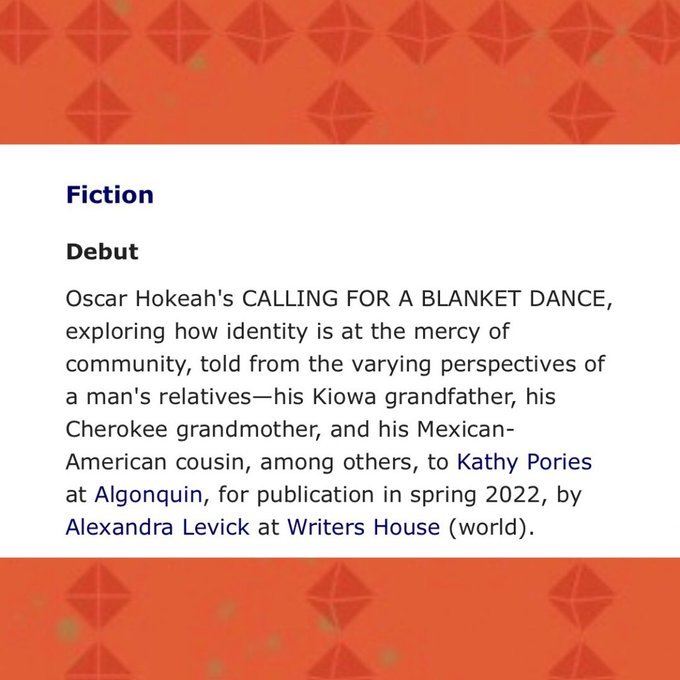
The heart of the novel has to do with family, naw thep'thay'gaw, and how families show up for each other. The title of the novel comes from an important ritual in powwow culture. When we call for a blanket dance, in essence what we’re doing is asking for the community to step up and help out someone in need. The main character, Ever Geimausaddle, has a host of family members willing to do just that, willing to hear the call, step up to the edges of the blanket, and offer a piece of themselves for his greater healing.
The structure of the novel is told in 12 chapter/narrator fashion, and we hear from different family members, like grandparents, aunties, uncles, cousins, and then in the last chapter Ever Geimausaddle speaks for himself. Ever's identity becomes shaped by Kiowa, Cherokee, and Mexican relatives, and the crux of the novel has his family concerned for his changing identity as a man. His Cherokee grandmother, Lena Stopp, fears the brutal trauma he experiences as an infant will forever leave him "witched," while his Kiowa grandfather, Vincent Geimausaddle, fights to change Ever's fate with his dying breath. Moreover, his Mexican American cousin, Araceli Chavez, is the conduit for deep familial healing. So family member after family member step up to the edges of the blanket to offer a piece of themselves. But will this be enough?
As Ever grows into adulthood, readers will get to explore large and unique themes situated in tribally specific values, like tribal masculinity, communal ideology, and collective identities. Furthermore, readers will follow Ever Geimausaddle through the ups and downs of living an intertribal and multicultural life in Oklahoma, offering a slice of America very few know about.
I'd like to thank Algonquin Books and Workman Publishing for this amazing opportunity. I'm excited to offer readers a unique experience through my gritty and honest voice. I can promise you this: my hard-hitting conversational style is nothing like you've experienced before.
Stay tuned here on my blog or on my social media accounts for the latest news from my debut novel: CALLING FOR A BLANKET DANCE. Please help a new writer by sharing with friends and family. The novel is posted on Goodreads so don't forget to add this novel on your "To Read" list. Soon I'll be announcing the cover reveal. It's an amazing cover from a very talented artist. Can't wait to share the cover and the artist with everyone.
More soon...
Indian Child Welfare Novel: Lessons in Cooking Coded Cake
If you're getting silenced, or an attempted silence, as an artist/writer this is a sign you're doing something right. The ACLU has extensive documentation about the rights of artists to speak our minds and advocate for communities. Intimidation tactics from white supremacists didn't stop me from writing my first novel, UNSETTLED BETWEEN, and they won't stop me from writing my "ICW" novel. Power hungry racists will always fear artists. We have a power they'll never have: the ability to move audiences to connect with a deeper sense of their own humanity. You might be wondering why I'm writing this post. It's not exactly one of my typical updates on my writing projects. Usually I use this space to brainstorm concepts in a story I'm writing, but today I'd like to talk about how fiction writers can capture real life in their pages. Moreover, how artists overcome coercive tactics meant to silence our voices.
You might be wondering why I'm writing this post. It's not exactly one of my typical updates on my writing projects. Usually I use this space to brainstorm concepts in a story I'm writing, but today I'd like to talk about how fiction writers can capture real life in their pages. Moreover, how artists overcome coercive tactics meant to silence our voices.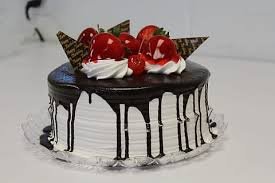 As you already know, when I write I do so from personal experience. I take what I see around me, whether in my personal life or the lives of the people in my proximity, and I transform it into a fictional space. So there are a few ways in which I pull this off. I've had people ask me, "How can you do that and not offend people?" Well, the short answer: It can still rub certain people the wrong way. But the truth and honesty in the work will always shine through and people can't deny the craftsmanship in turning real life into fiction. At the end of the day, only the villains will become detractors. Most will be flattered. I always say, "If you don't want to be a villain in fiction, the don't be one in real life."The primary things to consider are more obvious: change names, alter places, and code oppression. The issue for white supremacists is their legacy. If you, and others around you, talk and gossip about their behavior, it's already known in the community how they are oppressive. Just enough has to come to the surface before those in higher positions of power catch wind. The system will ignore oppressive acts only as long as it has to. Once something becomes news worthy, then those in the highest reaches of power will put a stop to it. The oppressors will do everything they can to keep things from getting to a boiling point. Hence the suppressive tactics and attempts at silencing artists.
As you already know, when I write I do so from personal experience. I take what I see around me, whether in my personal life or the lives of the people in my proximity, and I transform it into a fictional space. So there are a few ways in which I pull this off. I've had people ask me, "How can you do that and not offend people?" Well, the short answer: It can still rub certain people the wrong way. But the truth and honesty in the work will always shine through and people can't deny the craftsmanship in turning real life into fiction. At the end of the day, only the villains will become detractors. Most will be flattered. I always say, "If you don't want to be a villain in fiction, the don't be one in real life."The primary things to consider are more obvious: change names, alter places, and code oppression. The issue for white supremacists is their legacy. If you, and others around you, talk and gossip about their behavior, it's already known in the community how they are oppressive. Just enough has to come to the surface before those in higher positions of power catch wind. The system will ignore oppressive acts only as long as it has to. Once something becomes news worthy, then those in the highest reaches of power will put a stop to it. The oppressors will do everything they can to keep things from getting to a boiling point. Hence the suppressive tactics and attempts at silencing artists. The last thing they want is a permanent record of their hate. Remember: we're all judged by our endings. The ones in real life, and the ones we write. If the last thing people know about you is that you're a pedophile, then everyone in the community will remember you as a pedophile. It doesn't matter how much you've done before. Preying on a child, even if that child was a vulnerable disadvantaged teen, is inexcusable. And they might think people don't know they were fired from a job working with youth. But the right people always know. The next time you see them ask, "Why were you fired from that youth organization?" Likewise, if community members read coded fiction stories divulging poorly treated vulnerable populations, those in the community will know the code. They'll know who so-and-so is, and if they don't, all they have to do is ask relatives who will ask other relatives. In small town politics, word moves fast. And the power of gossip is something no one should underestimate. Believe me when I say this: Writers are seductive monsters. Our love lulls audiences into a mind altering hypnosis. And we're very aware of what we're doing. I've said this before,"We’re persuasive colonizers seeking to intrude on your sensibilities."When taking a real event, involving real life people, I not only change their names and description, but I also layer each story with other layers of truth. So what I'm doing is stacking multiple real life situations atop each other, and this turns a true story into fiction. To be completely honest, a single interesting event in real life is not good enough to entice a reader. You have to add more and more. Like sugar is the thing that makes a cake taste great, but it's the multitude of ingredients that give you the experience of eating a cake. Otherwise, we'd all be pouring bags of sugar down our throats, lol. How the ingredients are cooked together and presented make for a complete "cake experience." Turning real life into fiction works the same way.
The last thing they want is a permanent record of their hate. Remember: we're all judged by our endings. The ones in real life, and the ones we write. If the last thing people know about you is that you're a pedophile, then everyone in the community will remember you as a pedophile. It doesn't matter how much you've done before. Preying on a child, even if that child was a vulnerable disadvantaged teen, is inexcusable. And they might think people don't know they were fired from a job working with youth. But the right people always know. The next time you see them ask, "Why were you fired from that youth organization?" Likewise, if community members read coded fiction stories divulging poorly treated vulnerable populations, those in the community will know the code. They'll know who so-and-so is, and if they don't, all they have to do is ask relatives who will ask other relatives. In small town politics, word moves fast. And the power of gossip is something no one should underestimate. Believe me when I say this: Writers are seductive monsters. Our love lulls audiences into a mind altering hypnosis. And we're very aware of what we're doing. I've said this before,"We’re persuasive colonizers seeking to intrude on your sensibilities."When taking a real event, involving real life people, I not only change their names and description, but I also layer each story with other layers of truth. So what I'm doing is stacking multiple real life situations atop each other, and this turns a true story into fiction. To be completely honest, a single interesting event in real life is not good enough to entice a reader. You have to add more and more. Like sugar is the thing that makes a cake taste great, but it's the multitude of ingredients that give you the experience of eating a cake. Otherwise, we'd all be pouring bags of sugar down our throats, lol. How the ingredients are cooked together and presented make for a complete "cake experience." Turning real life into fiction works the same way. Saying so-and-so is a racist and oppresses every dark skinned person they encounter is intriguing in the most awful way possible, but when you add that so-and-so has an opiate addiction and throws women under the bus--now we're getting deep and dirty. Take that and add how their child is a meth addict and they've used their power to clear criminal charges; then all of a sudden it's getting really real. But you get the picture. It's taking multiple real life events from different people around you and smashing them together.Writers sacrifice for the solitude needed to capture an entertaining version of real life. Ultimately, no matter how "literary," that's what we're doing, that's our job: to entertain. Audiences love stories flavored with the sweetest truth, savoring each bite like the latest gossip in town. They will read and reread pages in your novel to chew on the layers, to find the truth about the people they know. Now can you imagine anything better than cake?
Saying so-and-so is a racist and oppresses every dark skinned person they encounter is intriguing in the most awful way possible, but when you add that so-and-so has an opiate addiction and throws women under the bus--now we're getting deep and dirty. Take that and add how their child is a meth addict and they've used their power to clear criminal charges; then all of a sudden it's getting really real. But you get the picture. It's taking multiple real life events from different people around you and smashing them together.Writers sacrifice for the solitude needed to capture an entertaining version of real life. Ultimately, no matter how "literary," that's what we're doing, that's our job: to entertain. Audiences love stories flavored with the sweetest truth, savoring each bite like the latest gossip in town. They will read and reread pages in your novel to chew on the layers, to find the truth about the people they know. Now can you imagine anything better than cake?
(Images were borrowed from pixabay, pxfuel, piqsels and flickr)
The Crocodile, the Goat, and the Unicorn: Unique Approaches to Character Development by Unifying Karpman's Drama Triangle, Evolutionary Astrology, and Stanislavski's Method Acting
There I am, like you, and so many writers, sitting at my computer and starting a new writing project. I'm drawing up characters because this story has been running through mind for years and it's finally ready to go onto a page. Since I already have a working idea of who my main character is and her antagonist, I now need to weigh her against Karpman's drama triangle. What is her good, bad, and ugly? This is how I've drawn multidimensional characters for over 10 years. But then two other creative forms changed my approach: Evolutionary astrology and Stanislavski's method acting.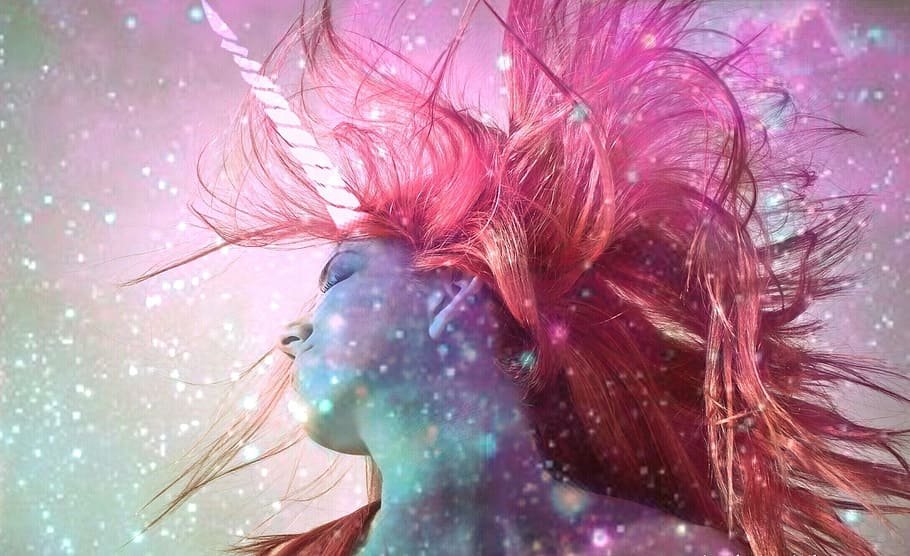 Those of you who have been following my blog for some time know that I'm a capricorn and if you follow my Twitter as well you'll see posts from time to time about being capricorn. I've followed astrology closely for about two years. I'm writing a character for another novel, or another novel that's rolling around in my mind right now, and astrology started as research for that character. Then I started to become more and more intrigued by it.So I'm a capricorn rising, capricorn sun, and libra moon in Western astrology, which is also called evolutionary astrology, and commonly practiced in North America and Europe. In Vedic astrology, which is the most commonly used form in Asia, I'm a capricorn rising, sagittarius sun, and virgo moon, with my moon nakshatra in uttra phalguni. If you follow astrology closely, you'll know what each of those mean, but if you don't it's how the stars were aligned the moment I was born and determines my personality, my ambitions, and my obstacles.So in both forms of astrology, I'm a capricorn, which isn't always the case because each measures birth timeframes differently. I'll not go into those details. But being a capricorn has always resonated with me.
Those of you who have been following my blog for some time know that I'm a capricorn and if you follow my Twitter as well you'll see posts from time to time about being capricorn. I've followed astrology closely for about two years. I'm writing a character for another novel, or another novel that's rolling around in my mind right now, and astrology started as research for that character. Then I started to become more and more intrigued by it.So I'm a capricorn rising, capricorn sun, and libra moon in Western astrology, which is also called evolutionary astrology, and commonly practiced in North America and Europe. In Vedic astrology, which is the most commonly used form in Asia, I'm a capricorn rising, sagittarius sun, and virgo moon, with my moon nakshatra in uttra phalguni. If you follow astrology closely, you'll know what each of those mean, but if you don't it's how the stars were aligned the moment I was born and determines my personality, my ambitions, and my obstacles.So in both forms of astrology, I'm a capricorn, which isn't always the case because each measures birth timeframes differently. I'll not go into those details. But being a capricorn has always resonated with me.
"In the end, you will find yourself with a long list of accomplishments and overcomes challenges that will mark your name, and these things you have done should bring you joy in the later years of your life because you decided that you would never quit." -- Bellatuscana
 For most of the last two years, I had been only aware of the capricorn sign symbolized by a climbing mountain goat. Then as I went deeper into researching astrology I discovered ancient astrology also symbolized the sign with a crocodile and a unicorn. So the cycle goes like this: the sign starts as a crocodile moves into a goat and then ends as a unicorn. So in it's lowest form, capricorns had strong crocodilian traits and were once viewed singularly as this reptile. Then at some point in human history, capricorn people evolved and started to act more like the mountain goat or a mythological sea goat. This is how the sign is currently symbolized. And so in the future, capricorn people, in their highest form of evolution, will start to take on traits of a mythological unicorn. The two horns of the goat fuse and turn into one, which symbolizes the spiritual use of the third eye.So how does all this pertain to Karpman's drama triangle and Stanislavski's method acting?Stephen Karpman developed a victim, rescuer, and persecutor psychotherapy model in 1961 for transactional analysis. In story writing terms, we writers modified this into a model for creating complex characters and applied the terms of victim, hero, and villain. So each character, aside from static characters, should have personality traits showing each of the three. This will reflect on the page as a real person to the reader, because, as Karpman pointed out in his model, people revolve between victim, rescuer, and persecutor in social situations. So if real folks do this, then so should your characters.
For most of the last two years, I had been only aware of the capricorn sign symbolized by a climbing mountain goat. Then as I went deeper into researching astrology I discovered ancient astrology also symbolized the sign with a crocodile and a unicorn. So the cycle goes like this: the sign starts as a crocodile moves into a goat and then ends as a unicorn. So in it's lowest form, capricorns had strong crocodilian traits and were once viewed singularly as this reptile. Then at some point in human history, capricorn people evolved and started to act more like the mountain goat or a mythological sea goat. This is how the sign is currently symbolized. And so in the future, capricorn people, in their highest form of evolution, will start to take on traits of a mythological unicorn. The two horns of the goat fuse and turn into one, which symbolizes the spiritual use of the third eye.So how does all this pertain to Karpman's drama triangle and Stanislavski's method acting?Stephen Karpman developed a victim, rescuer, and persecutor psychotherapy model in 1961 for transactional analysis. In story writing terms, we writers modified this into a model for creating complex characters and applied the terms of victim, hero, and villain. So each character, aside from static characters, should have personality traits showing each of the three. This will reflect on the page as a real person to the reader, because, as Karpman pointed out in his model, people revolve between victim, rescuer, and persecutor in social situations. So if real folks do this, then so should your characters.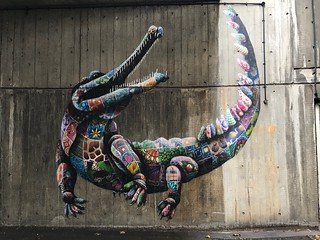 Now in my own writing, I tend to be pretty good about making my main characters into villains. I'm not sure why. Many writers will be protective of their main characters and make them so saintly they don't appear to be real people. I must be real crocodilian in my approach to character development, lol. I tend to want to throw my characters under the bus and have them appear to be unlikable. I am a big fan of the unlikable narrator, so that probably plays a part in it. Because I tend to lean heavily on the villain side of character development, I've used the drama triangle to make sure my characters also play hero and victim. This has saved me on a number of occasions by giving my character multiple dimensions.So there I am learning how capricorn in ancient astrology has these evolutionary patterns, and I'm a writer (the drama triangle is always floating around somewhere in the back of my mind). Suddenly, I think to myself, "What if I applied ancient astrology's approach with capricorn symbols to Karpman's model?" Then the villain becomes the crocodile, and the victim becomes the goat, and the hero becomes the unicorn. I've been gifted, aka cursed, with an overactive mind and imagination (great for storytelling but bad for peace of mind), so I suddenly start thinking in terms of "method acting."
Now in my own writing, I tend to be pretty good about making my main characters into villains. I'm not sure why. Many writers will be protective of their main characters and make them so saintly they don't appear to be real people. I must be real crocodilian in my approach to character development, lol. I tend to want to throw my characters under the bus and have them appear to be unlikable. I am a big fan of the unlikable narrator, so that probably plays a part in it. Because I tend to lean heavily on the villain side of character development, I've used the drama triangle to make sure my characters also play hero and victim. This has saved me on a number of occasions by giving my character multiple dimensions.So there I am learning how capricorn in ancient astrology has these evolutionary patterns, and I'm a writer (the drama triangle is always floating around somewhere in the back of my mind). Suddenly, I think to myself, "What if I applied ancient astrology's approach with capricorn symbols to Karpman's model?" Then the villain becomes the crocodile, and the victim becomes the goat, and the hero becomes the unicorn. I've been gifted, aka cursed, with an overactive mind and imagination (great for storytelling but bad for peace of mind), so I suddenly start thinking in terms of "method acting."
“Our demands are simple, normal, and therefore they are difficult to satisfy. All we ask is that an actor on the stage live in accordance with natural laws.” --
Konstantin Stanislavski begun the practice of method acting back in the early 1900s. The basic concept of the form is to "take on" traits of someone else or something else. This could mean an actor studying historical figures to such an intense degree that they "become" the person in behavior and thinking, like Kate Winslet in her portrayal of a former Nazi guard in The Reader. It also can mean an actor use the behavior of an animal to portray a specific depth, like Anthony Hopkins using traits of a lizard for his portrayal of serial killer Hannibal Lecter in The Silence of the Lambs.In the rapidity of an overactive imagination, I put the three together and started to make my drama triangle "character specific." So if my main character in my novel was like a spider in his villainy, then I asked myself: What animal would his victim and hero personas become? Or in astrological terms, what symbols would carry him through an evolutionary arch? If a crocodile can become a goat and then a unicorn, then a spider can become a bird and then a dragon.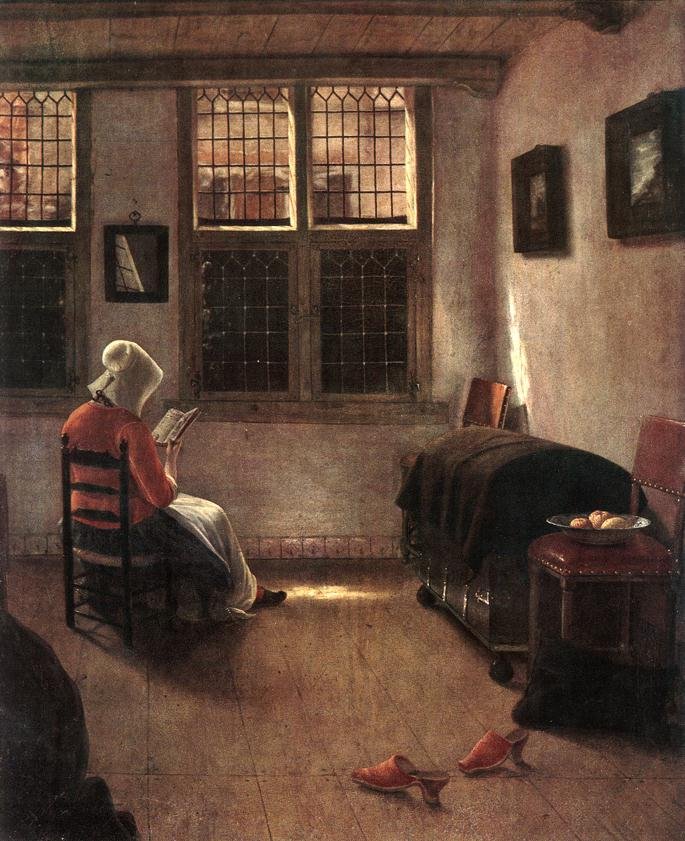 What's important to take away from this exercise is the freedom you obtain by marrying all three of these forms: drama triangle, evolutionary astrology, and method acting. By developing a "character specific" drama triangle, we as writers have a powerful tool to manifest complex characters out of thin air, like magicians mimicking the tools of a god. With the slight of hand, pencil and paper, screen and keyboard, we can hypnotize our audiences to feel as though they are participating in the lives of real people.
What's important to take away from this exercise is the freedom you obtain by marrying all three of these forms: drama triangle, evolutionary astrology, and method acting. By developing a "character specific" drama triangle, we as writers have a powerful tool to manifest complex characters out of thin air, like magicians mimicking the tools of a god. With the slight of hand, pencil and paper, screen and keyboard, we can hypnotize our audiences to feel as though they are participating in the lives of real people.
(Images were borrowed from pxfuel.com, maxpixel.com, flickr, and wikimedia commons)
#WritersLife: When Writers Dream of Characters in Their Novel
#WritersLife was the first thought I had when I woke. But I couldn't shake the deep depression taking control of me. I felt an immense sadness. It felt like I was so inadequate that I didn't matter to anyone. My life was so pointless and meaningless that no one would ever want to connect with me enough to care about my life. My mind kept circling around about how shitty a human being I was and how it didn't matter what I thought or felt. My chest was heavy, shoulders sunken, and I could feel the length of my jaw pulling downward. I had little energy. Just enough to zombie through the last two days.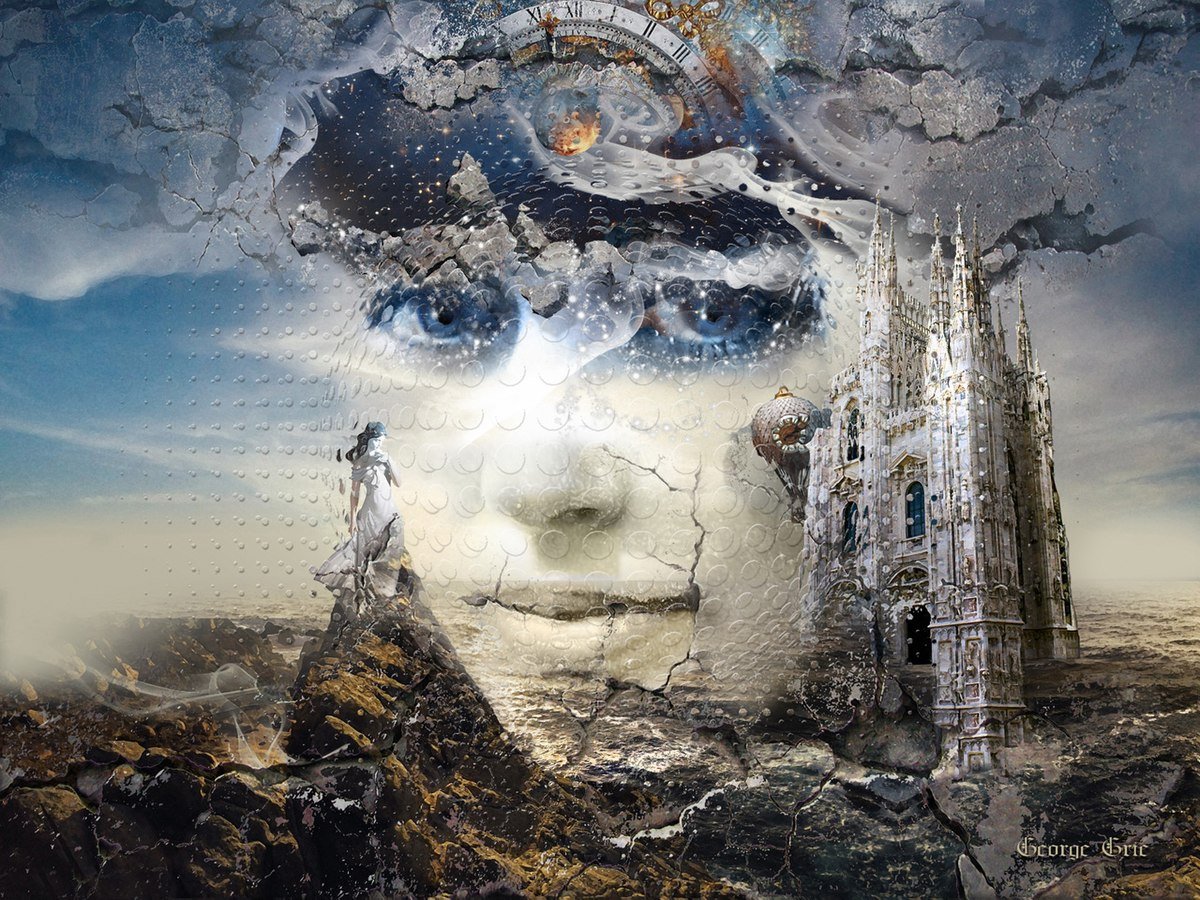 And it started with a vivid dream about a character, Jimena, in my novel, Unsettled Between.I've never had a reaction like this before. I've dreamt about characters and scenes and concepts for novels or short stories before (often in the waking moment between sleep and full consciousness), but I've never had such an emotional reaction. It's really odd and I'm still feeling remnants of it now. Yesterday was the worst of it.I'm not an emotional person. I get sad, but I don't tend to linger in it to a point I would call depression. I've been depressed before, but I tend to force myself into tasks that help alleviate those feelings. So when this feeling grabbed me over the last two days it was very alien, like someone else had stepped inside my body and had taken over.
And it started with a vivid dream about a character, Jimena, in my novel, Unsettled Between.I've never had a reaction like this before. I've dreamt about characters and scenes and concepts for novels or short stories before (often in the waking moment between sleep and full consciousness), but I've never had such an emotional reaction. It's really odd and I'm still feeling remnants of it now. Yesterday was the worst of it.I'm not an emotional person. I get sad, but I don't tend to linger in it to a point I would call depression. I've been depressed before, but I tend to force myself into tasks that help alleviate those feelings. So when this feeling grabbed me over the last two days it was very alien, like someone else had stepped inside my body and had taken over.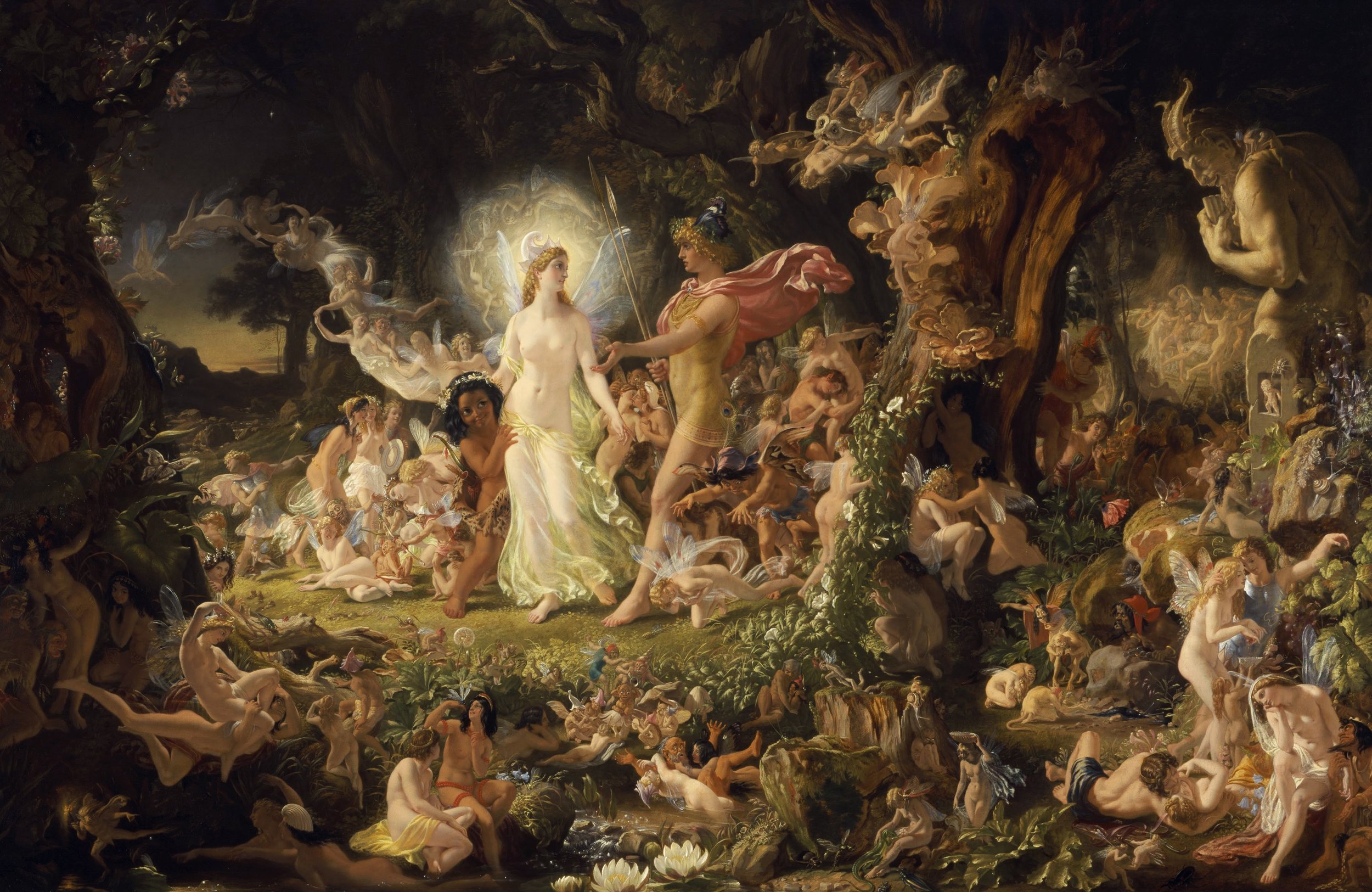 The dream was about me interacting with a character, Jimena. She's not a major character in my novel but she's important to certain stories in the collection.In the dream, Jimena lead me from one place to another but it was almost like I was floating around her as opposed to her leading me. It was like I took on her energy so she could act "normal" or front like she was okay. I watched as she displayed happiness and confidence to people around her, but I carried her sadness. That's weird, isn't it? How could I carry sadness for her?Another odd occurrence happened when I woke. There was a lightening flash that lit up my bedroom. It was so bright I thought it was storming outside. We had rain the day before so I thought maybe storms had come in overnight. But when I looked outside it was overcast but no storms. The flash was like a strobe coming from inside my room--not outside.Now I've carried this unbearable sadness with me for two days. The depression is so harsh that I haven't gotten on social media in the last two days. I'm a junkie or have bouts of social media binges so going two days with no interest in social media is odd. This is likely the case for many of us.
The dream was about me interacting with a character, Jimena. She's not a major character in my novel but she's important to certain stories in the collection.In the dream, Jimena lead me from one place to another but it was almost like I was floating around her as opposed to her leading me. It was like I took on her energy so she could act "normal" or front like she was okay. I watched as she displayed happiness and confidence to people around her, but I carried her sadness. That's weird, isn't it? How could I carry sadness for her?Another odd occurrence happened when I woke. There was a lightening flash that lit up my bedroom. It was so bright I thought it was storming outside. We had rain the day before so I thought maybe storms had come in overnight. But when I looked outside it was overcast but no storms. The flash was like a strobe coming from inside my room--not outside.Now I've carried this unbearable sadness with me for two days. The depression is so harsh that I haven't gotten on social media in the last two days. I'm a junkie or have bouts of social media binges so going two days with no interest in social media is odd. This is likely the case for many of us.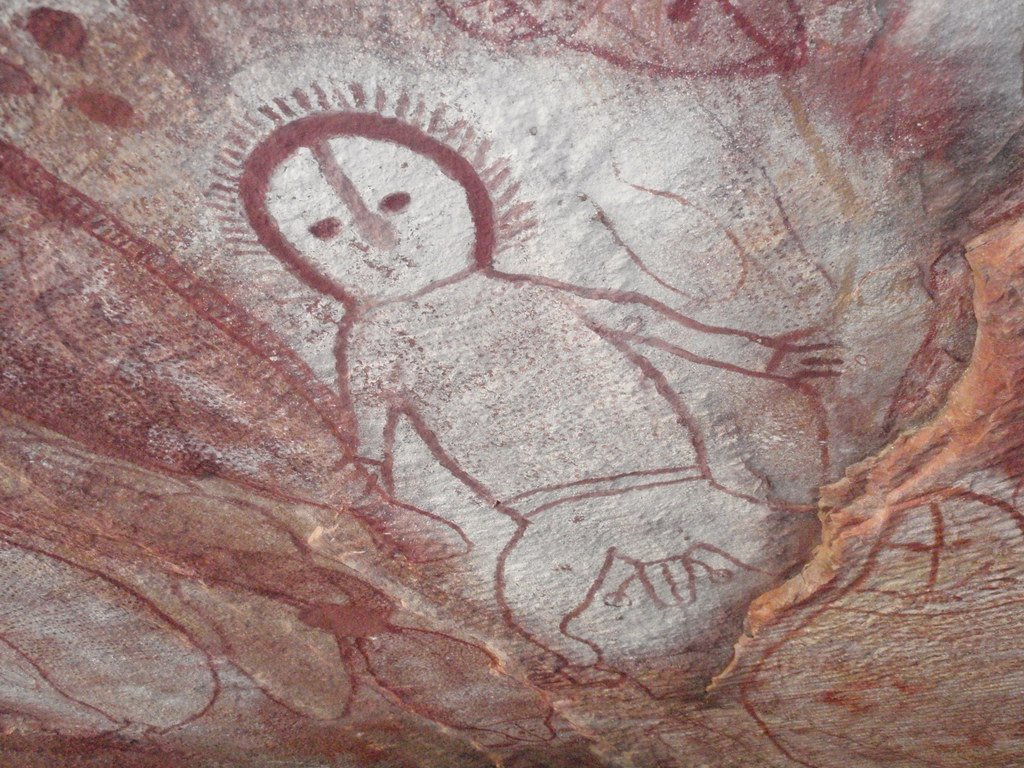 Initially, I tried to work this out as some residual part of my past, like something Jungian I hadn't addressed. But then suddenly I realized the character goes through something in the novel that was emotionally challenging for her. But I didn't give it the emotional weight. Meaning, maybe I wasn't honest enough about how much she hurt. I wish I could tell you what specifically I'm talking about in the novel, but I'm going to have to wait until it's released before I can put the two together.Ultimately, I feel like I didn't do her character justice and she came to me in my dream to show me how she felt. That sounds odd, I know. But I can't make sense of why I'd have these emotions associated to that dream about this specific character. It's the only conclusion I can draw.In fact, I had to write my agent, who received my most recent draft a couple weeks ago. I told her about the dream, and she gave me the green light to go back into the novel and revise Jimena's portion. I do feel better now that I can revise to Jimena's liking. But what an interesting emotional ride. As a writer, I sometimes feel like I know how to pull details from my psyche to write about. But this is a first.Have you dreamed about a character in one of your story lines? If so, what was your experience? A part of me is desperately searching for kindred spirits. I hope I'm not alone in this. I'm hoping this is one of those #WritersLife hashtag moments.
Initially, I tried to work this out as some residual part of my past, like something Jungian I hadn't addressed. But then suddenly I realized the character goes through something in the novel that was emotionally challenging for her. But I didn't give it the emotional weight. Meaning, maybe I wasn't honest enough about how much she hurt. I wish I could tell you what specifically I'm talking about in the novel, but I'm going to have to wait until it's released before I can put the two together.Ultimately, I feel like I didn't do her character justice and she came to me in my dream to show me how she felt. That sounds odd, I know. But I can't make sense of why I'd have these emotions associated to that dream about this specific character. It's the only conclusion I can draw.In fact, I had to write my agent, who received my most recent draft a couple weeks ago. I told her about the dream, and she gave me the green light to go back into the novel and revise Jimena's portion. I do feel better now that I can revise to Jimena's liking. But what an interesting emotional ride. As a writer, I sometimes feel like I know how to pull details from my psyche to write about. But this is a first.Have you dreamed about a character in one of your story lines? If so, what was your experience? A part of me is desperately searching for kindred spirits. I hope I'm not alone in this. I'm hoping this is one of those #WritersLife hashtag moments.
Support a Native owned Etsy shop, Allies United, where I offer unique merch for allies of social justice movements, like MMIW, Native Lives Matter and Black Lives Matter. Take a look inside my Etsy shop here: etsy.com/shop/AlliesUnited.
(Images were borrowed from wikimedia, wikipedia, and flikr)
Novel DNA: How Writing Chapters can Change the World
What to do with a great idea? Let's sit down and map out a novel. Writing in the dark is a popular way of writing short stories. We get an idea. We pull out the laptop. We write until everything is on the page. As we write, we don't know where the story will lead and this suspense and feeling of surprise keeps us writing, it builds adrenaline, and keeps us guessing as we finish a story. But there may need to be a different approach when it comes to a 25 chapter novel.
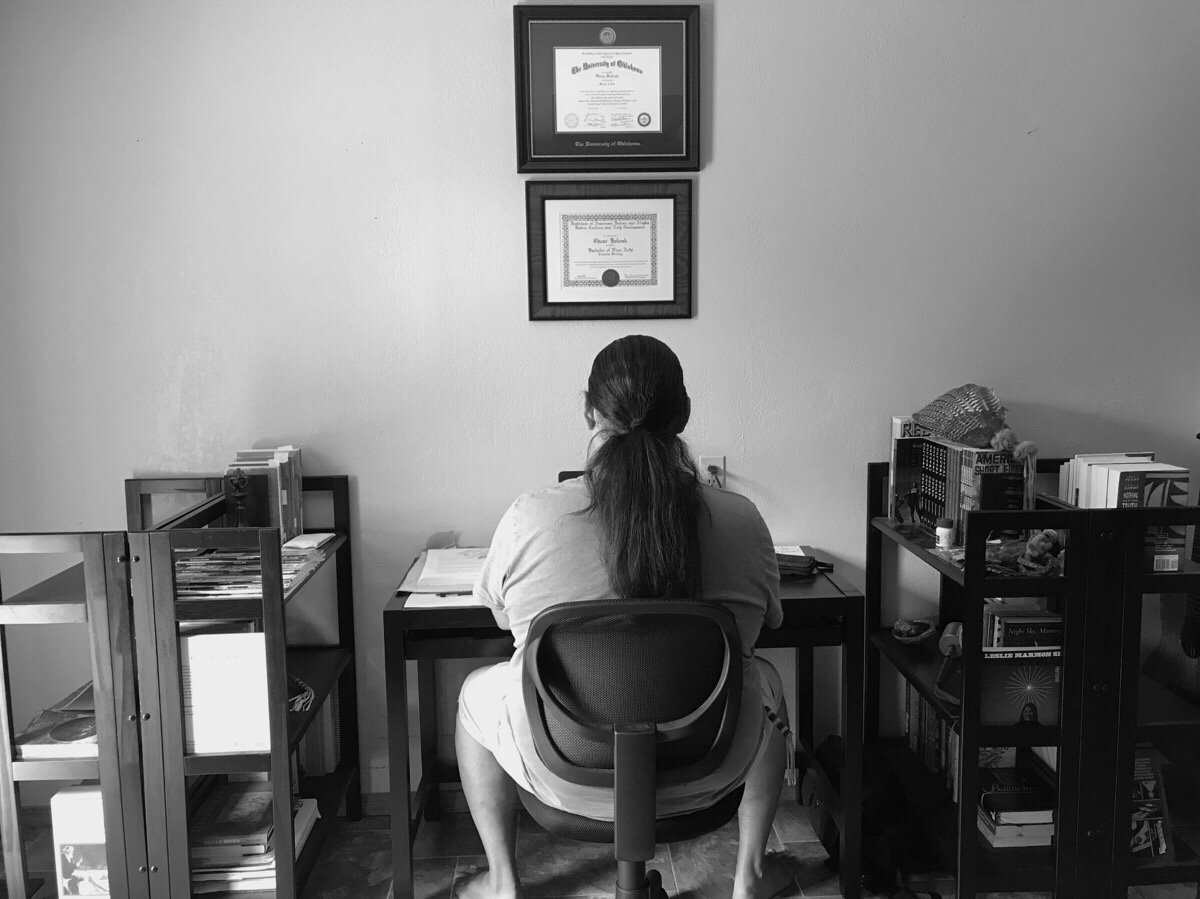
I'm not going to tell anyone how to write. We all have our nuanced approach. But what I'm going to do is share with you how I go about writing my novels. And where novel writing can be different and similar to short story writing. We've all gotten to the point where we've asked ourselves: How do I write a novel? Do I outline? If so, how do I outline multiple chapters to create an interesting story arch? Do I write in the dark for 80,000 words? If so, will my novel have deadly and boring lulls?
Do a little cross compare with my approach and fill in with your personal style. Make the process your own. That's one of the important components to any creative approach.
First thing I do: Create a OneNote file. The tabs work great to create space for each individual chapter. I always have a "development" tab, where I create multiple pages for subjects like characters, plot, subplots, story arch, etc. But I create a tab for each chapter so I can brainstorm elements within each chapter. What I need to consider for one chapter is not going to work for another. If there is a clear build up and tension to the novel, then every chapter will need a lot of space to create the nuances.
Example: If the main character is taking a child into custody in the first chapter, then I'll need space to brainstorm her approach, which will be determined by the other characters confronting her and how she will overcome that confrontation. This is radically different than the second chapter, where the main character might be confronting a whole different situation, like children adjusting to a new foster home.
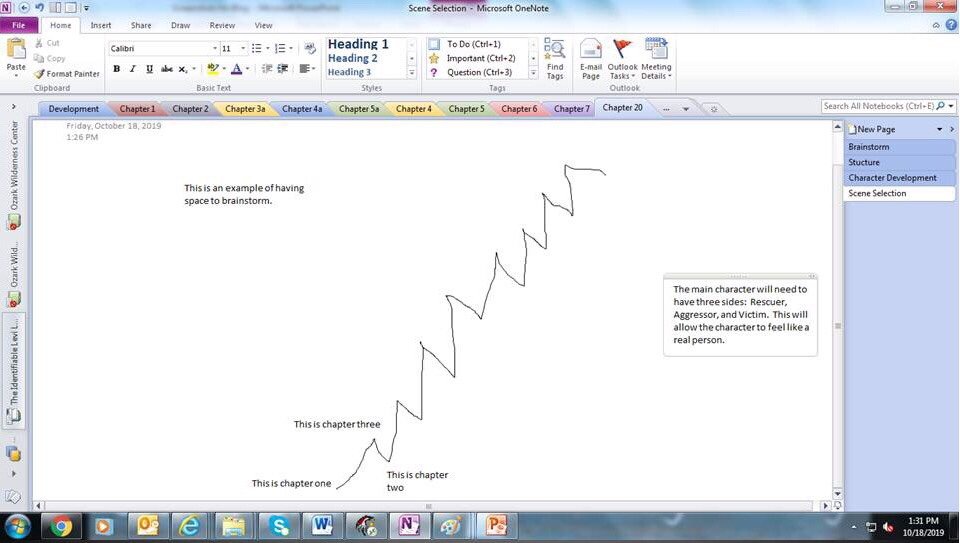
Also, I like to have all the tools in OneNote. I can draw out the build up as you can see in the image above. I can also write text boxes for each idea I need to address for development. I can also move those boxes around.
So once I have the space established to develop my novel, I then go into writing a "synopsis" of sorts. It's a line by line breakdown of the novel. It's not a full synopsis by any sorts but it gives me a quick snapshot of the progression of the main character's obstacles. Also it gives me an opportunity to consider subplots. In a novel, it's important to establish subplots that mirror or give us a break from the main story line.
Example: If the main character is a young man who is trying to overthrow his corrupt boss, then the reader will need to take a break from the ugliness transposed between the two. We can see him with his family and his family gives him stress relief as he battles with this boss, but it will simultaneously show the family putting pressure on him to be successful at work. The subplot shows a different side to this young man, and it also adds to the tension while giving the reader an alternate storyline to follow.
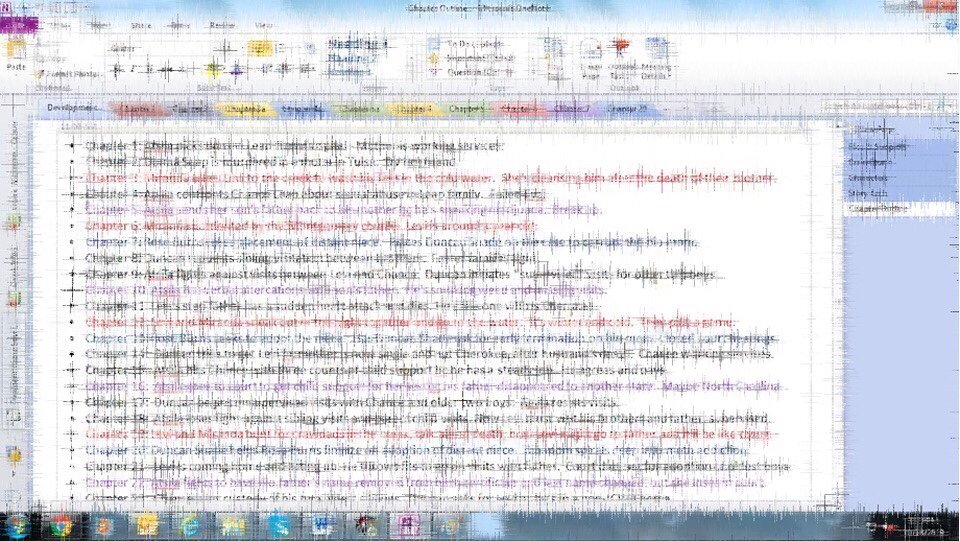
So I had to "shear" the screen because the above image is a screenshot from the current novel I'm working on. I don't want to give away any details in the novel before it reaches fruition. But as you can see in the above image, it shows a "list" of each chapter from chapter one to chapter 25. I'd also like for you to notice the different colors on each line. There are chapter breakdowns in black, red, blue, and purple. The black represents the main plot line, the red is a tightly related subplot (a subplot closely aligned with the main plot), while the blue and purple are subplots that show a seperate but nuanced mirror to the main plot (gives the reader an emotional "break" from the plot while also increasing tension).
You're probably asking why I go to such lengths to map out my novels. For me the pleasure of writing isn't only in the initial creation of a piece. I like the practice of "writing in the dark" when it comes to short stories. But when we're trying to hold someone's attention for a long period of time, there needs to be numerous components to keep the reader entertained. This is the reason I write. For other people to have as much pleasure reading the novel as I had creating it. When it's two fold, we as writers get more in return because then we have happy fans who are eager to talk about and share our writing. In order to reach that goal, there is a lot of layers to create.
I enjoy the macro development as much as the micro. As I create the big picture, outlining chapter by chapter how the main character will survive all the obstacles I throw in her way, the concept building can be euphoric. It's a physical reaction. After I've written the first draft and I'm finally ready for the details (the micro), I'm getting adrenaline from witnessing the spirit of the novel come alive in the words. Suddenly, my idea that corruption can be beaten becomes emotionally tangible when the main character throws a fist full of contracts into an evil boss's face. It all comes together.
There is nothing more exciting than seeing the DNA of a novel build word by word into a complex living system. And it takes hard mental labor to structure a story so perfectly that someone can read your work and suddenly choose to transform their worldview to include people you know and experiences you've lived. To make that connection, it's worth all the time, thought, and energy spent.
Support a Native owned Etsy shop, Allies United, where I offer unique merch for allies of social justice movements, like MMIW, Native Lives Matter and Black Lives Matter. Take a look inside my Etsy shop here: etsy.com/shop/AlliesUnited.
Real Life Turns Into Fiction
I've said this before: If you don't want to be villain in fiction then don't be one in real life. The beautiful thing about graduating from two different writing programs are the connections made between creative writers and journalists. We tend to be tasked with a similar challenge. How to captivate an audience.Twitter can be a great place for inspiration. I haven't posted on my blog in a while. I apologize. Since signing with my literary agent, I've been busy meeting deadlines and tightening up my novel-in-collection, Unsettled Between. A great opportunity has landed in my lap so I've thrown myself into the writing. I expect to achieve a great work of fiction and I'm excited for audiences to engage in the material.I was on Twitter last night and there was a small exchange. It was about personal histories laced into the writing of fiction. I draw from real life. It's been odd how very clear storylines play out in my personal life. Maybe it's my lens. I'm a writer. I see story everywhere I look. But when a clearly defined villain oppresses people in a certain environment, it's hard to ignore, and then the little minions enslaved by these oppressors add interesting subplots. Soon I have an entire novel's worth of fiction to write.I could go on my social media and blast people (we see that often), but I find it more beneficial to mold those personal experiences into a storyline and package it in a way that is entertaining, and available for audiences to reflect.You must realize something about artists: our only loyalty is to the well being of the community. We are guided by tribal justice. The main component for tribal justice? To put everything out in front of the public, make everyone aware of the problem, let the community's judgement become the justice. Similarly, this is the task of journalists as well. Zitkala Sa wrote a story, The Trial Path, where a young man had to face the judgement of his community, and every time I think of my obligation as a writer I think of this story.We have several platforms, but the one most powerful is the one that becomes a part of a continuing literature situated in a historical dialogue. Those who are interested in a legacy should be especially aware that intelligent people can discern the fleeting methods from the ones that stick around for a generation.
Zitkala Sa wrote a story, The Trial Path, where a young man had to face the judgement of his community, and every time I think of my obligation as a writer I think of this story.We have several platforms, but the one most powerful is the one that becomes a part of a continuing literature situated in a historical dialogue. Those who are interested in a legacy should be especially aware that intelligent people can discern the fleeting methods from the ones that stick around for a generation.
Support a Native owned Etsy shop, Allies United, where I offer unique merch for allies of social justice movements, like MMIW, Native Lives Matter and Black Lives Matter. Take a look inside my Etsy shop here: etsy.com/shop/AlliesUnited.
(The image was borrowed from wikimedia commons)
Twitter Serves Minority Writers: Intro to New Agent & #DVpit Success
Metaphorically #DVpit becomes water. Likewise, I could say Twitter is some type of container--a canteen maybe--something tethered to your belt. Whether you've been slinging a sledge hammer to break rocks or ripping callouses off your hands for grip on a climb, you're exhausted and you could use a drink. What you need is opportunity and energy to keep climbing, to keep breaking those rocks.I've said this a number of times on my blog. One of the biggest obstacles for minority writers is opportunity. There can be a number of reasons why you might not see much diversity at your writer's conference. Questions race through our minds. Where am I going to get the resources to attend? Who's going to take care of my kids? Will I lose my job? How will I pay my bills? And those are only a few of the questions. Economic disparity for minorities is not a new topic. It's easy to see how avenues for success can close down for a minority writer seeking to give voice to the voiceless, to represent her community in a genuine way.Little did I know #DVpit would be an environment for such opportunity. I read their website (www.dvpit.com) and I jumped onto their Twitter (@DVpit_). I understood the concept and was hopeful. The event was started by Beth Phelan and what grabbed me was the description:
"#DVpit is a Twitter event created to showcase pitches from marginalized voices that have been historically underrepresented in publishing. This includes (but is not limited to): Native peoples and people of color; people living and/or born/raised in underrepresented cultures and countries; disabled persons (including neurodiverse); people living with illness; people on marginalized ends of the socioeconomic, cultural and/or religious spectrum; people identifying within LGBTQIA+; and more." -- Beth Phelan.
After reading the description, I marked it on my calendar and started to prepare my pitch. I wasn't sure of what was to come of this "Diverse Voices Pitch" event, aka #DVpit, but I knew I had to try. What happened was this: I started to get "likes" or clicks which are hearts on Twitter. This is a good sign because a "like" means, "Hey, send me a query; I like what you're writing." So that's what I did. I had five agents click so I sent out five queries and I received five requests for manuscripts (two full and three partial). All five were from large literary agencies in New York and California. Oddly enough two of the agents were from the same agency so they worked out who would read the manuscript.Long story short, I signed with an agent. It took one week to filter through the process, and when I had to pull my submissions with the other agents they emailed back saying their congratulations. One of the agents read the full manuscript even though she wouldn't be representing the novel. She was very kind and generous with her compliments. I am completely humbled by it all.In this, I must give a big thank you to Beth Phelan for creating a space where minorities can navigate environments they might not otherwise be able. I highly recommend minority writers to seek out #DVpit for 2019. After looking into this event I also ran across other Twitter events which offer similar opportunities for writers, like #Pitmad, #PitchWars, #PitDark, and #PBPitch. I recommend writers to look into which pitching event fits your genre and participate. Take the time to develop your pitch, as well as your book (the market is still competitive and there is no guarantee).I've saved the best for last: I'm proud to announce I'm rep'd by Allie Levick of Writers House Literary Agency. I can't say enough about how excited I am. My palms have ripped through callouses getting to the next hold, and having Allie on my side makes me optimistic about the next climb. She is now representing my novel, UNSETTLED BETWEEN. You can find her via the Writers House website, www.writershouse.com, her personal website, www.alexandralevick.com, or her Twitter, @AllieLevick.
What happened was this: I started to get "likes" or clicks which are hearts on Twitter. This is a good sign because a "like" means, "Hey, send me a query; I like what you're writing." So that's what I did. I had five agents click so I sent out five queries and I received five requests for manuscripts (two full and three partial). All five were from large literary agencies in New York and California. Oddly enough two of the agents were from the same agency so they worked out who would read the manuscript.Long story short, I signed with an agent. It took one week to filter through the process, and when I had to pull my submissions with the other agents they emailed back saying their congratulations. One of the agents read the full manuscript even though she wouldn't be representing the novel. She was very kind and generous with her compliments. I am completely humbled by it all.In this, I must give a big thank you to Beth Phelan for creating a space where minorities can navigate environments they might not otherwise be able. I highly recommend minority writers to seek out #DVpit for 2019. After looking into this event I also ran across other Twitter events which offer similar opportunities for writers, like #Pitmad, #PitchWars, #PitDark, and #PBPitch. I recommend writers to look into which pitching event fits your genre and participate. Take the time to develop your pitch, as well as your book (the market is still competitive and there is no guarantee).I've saved the best for last: I'm proud to announce I'm rep'd by Allie Levick of Writers House Literary Agency. I can't say enough about how excited I am. My palms have ripped through callouses getting to the next hold, and having Allie on my side makes me optimistic about the next climb. She is now representing my novel, UNSETTLED BETWEEN. You can find her via the Writers House website, www.writershouse.com, her personal website, www.alexandralevick.com, or her Twitter, @AllieLevick.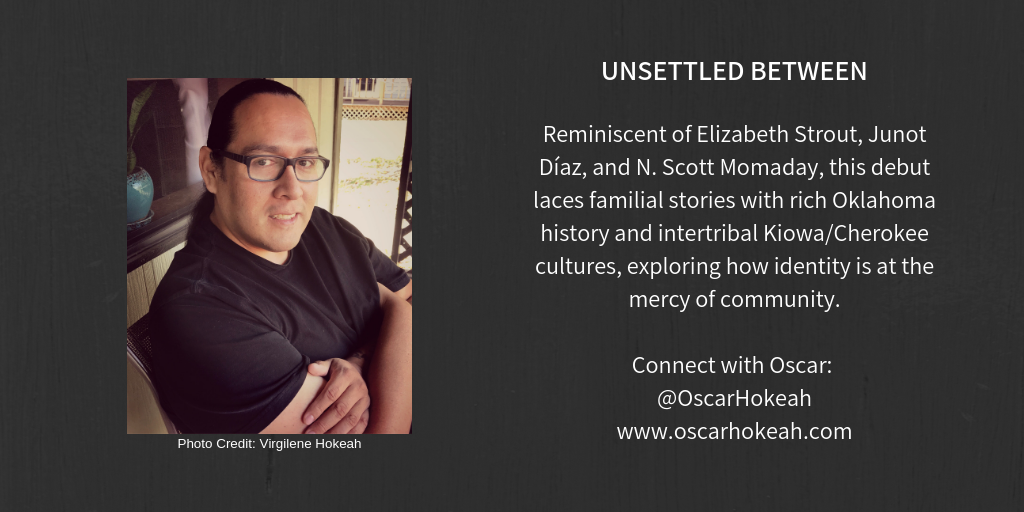
Twitter #DVpit & Announcements
Often we spend so much time looking down at our phones we forget to look up. I catch myself looking at the stars at night and the moving clouds in the day, realizing I'm watching them like I had when I was kid. Those were days before Reasor's Grocery Store in Tahlequah moved from Choctaw Street to Muskogee Avenue, and back when there was a drive-in theater outside my aunt's house on the southside of Lawton. Back then, we never looked down. I watch my kids and can see the pure optimism they carry in every moment, and I think that's what we admire about children. We say things like, "I wish I had just a little of their energy," and I wonder if what we really desire is to live every moment with sheer optimism. That's where they get their energy. Children have this way in the world which always holds onto the best in each moment.Today I have some great news to share. And it brings me some much needed optimism. First, I'm going to have to apologize for having went a few weeks without posting. I have great followers and each of you say profound things on my blog which blow me away. Often I find myself contemplating new avenues of thought after an exchange of ideas. For that I'm grateful, and for the same reason, I apologize for disappearing into the shadows.I'd like to say it was for good reason. I've been writing. More importantly, I've been preparing my novel, Unsettled Between, for review by agents. And that brings me to my news.Without saying too much, I participated in a Twitter pitch event called #DVpit and had some amazing results. I signed with a literary agent who will represent Unsettled Between.I can't believe my luck/fate/circumstances. We've decided to make a formal announcement this upcoming Thursday. I'll post her name and the agency she works for and her social media outlets in a couple of days. Look for the post here on my blog. We signed the agreement on Friday so we've had just a few days to move things along. I'll say this: She's already given me the editorial letter and hands down the adjustments will make the novel better.I'll save the rest for Thursday. I don't want to get too far ahead of myself. But what a great day to look up.
I watch my kids and can see the pure optimism they carry in every moment, and I think that's what we admire about children. We say things like, "I wish I had just a little of their energy," and I wonder if what we really desire is to live every moment with sheer optimism. That's where they get their energy. Children have this way in the world which always holds onto the best in each moment.Today I have some great news to share. And it brings me some much needed optimism. First, I'm going to have to apologize for having went a few weeks without posting. I have great followers and each of you say profound things on my blog which blow me away. Often I find myself contemplating new avenues of thought after an exchange of ideas. For that I'm grateful, and for the same reason, I apologize for disappearing into the shadows.I'd like to say it was for good reason. I've been writing. More importantly, I've been preparing my novel, Unsettled Between, for review by agents. And that brings me to my news.Without saying too much, I participated in a Twitter pitch event called #DVpit and had some amazing results. I signed with a literary agent who will represent Unsettled Between.I can't believe my luck/fate/circumstances. We've decided to make a formal announcement this upcoming Thursday. I'll post her name and the agency she works for and her social media outlets in a couple of days. Look for the post here on my blog. We signed the agreement on Friday so we've had just a few days to move things along. I'll say this: She's already given me the editorial letter and hands down the adjustments will make the novel better.I'll save the rest for Thursday. I don't want to get too far ahead of myself. But what a great day to look up.
Hyperlocal Advocacy in Native American Literature
I've been promoting my writing on my Twitter account for a few months now. Slowly but surely I'm getting more and more engagement and I'm nearing the cusp of 9K followers, and hoping to hit the 10K plus realm within a week or so. One of my followers, and now a tried a true fan, read through each of my short stories and came up with an interesting descriptor of my writing: hyperlocal. As soon as I read the phrase it hit me as so succinct I could not help but become fascinated. This term may have been utilized in creative circles for some time. I'm not sure. But its my first time engaging with it. Largely, I'm interested in the description because of how accurately it describes my writing.In my bio you'll read how I've captured my writing up to this point, and I've said things like "regionally specific" and focusing on Kiowa and Cherokee communities like Lawton (Kiowa) and Tahlequah (Cherokee). Now those from Oklahoma will quickly point out how Lawton is Comanche Nation central, and they'd be hypothetically correct. But geographically I argue these boundaries are not fixed and never have been.I'd say Kiowa, Comanche, and Apache (KCA) nomadic range in contemporary society is typically between OKC and Lawton, but you'll find our scouting parties traveling further out (all this is a cultural rehearsal in a historical context based in nomadic practices that have been a part of our cultures for hundreds if not thousands of years). You'd actually have to have grown up inside a Kiowa, Comanche, and/or Apache family to fully understand this nuanced "roaming" aspect of our culture. Once you understand, you can see how our gourd dance culture is so deeply imbedded in other tribal practices across the United States. An example? Our, Kiowa and Comanche, gourd dances have widespread practice within Navajo communities of New Mexico and Arizona, but other tribes in the United States as well.
As soon as I read the phrase it hit me as so succinct I could not help but become fascinated. This term may have been utilized in creative circles for some time. I'm not sure. But its my first time engaging with it. Largely, I'm interested in the description because of how accurately it describes my writing.In my bio you'll read how I've captured my writing up to this point, and I've said things like "regionally specific" and focusing on Kiowa and Cherokee communities like Lawton (Kiowa) and Tahlequah (Cherokee). Now those from Oklahoma will quickly point out how Lawton is Comanche Nation central, and they'd be hypothetically correct. But geographically I argue these boundaries are not fixed and never have been.I'd say Kiowa, Comanche, and Apache (KCA) nomadic range in contemporary society is typically between OKC and Lawton, but you'll find our scouting parties traveling further out (all this is a cultural rehearsal in a historical context based in nomadic practices that have been a part of our cultures for hundreds if not thousands of years). You'd actually have to have grown up inside a Kiowa, Comanche, and/or Apache family to fully understand this nuanced "roaming" aspect of our culture. Once you understand, you can see how our gourd dance culture is so deeply imbedded in other tribal practices across the United States. An example? Our, Kiowa and Comanche, gourd dances have widespread practice within Navajo communities of New Mexico and Arizona, but other tribes in the United States as well.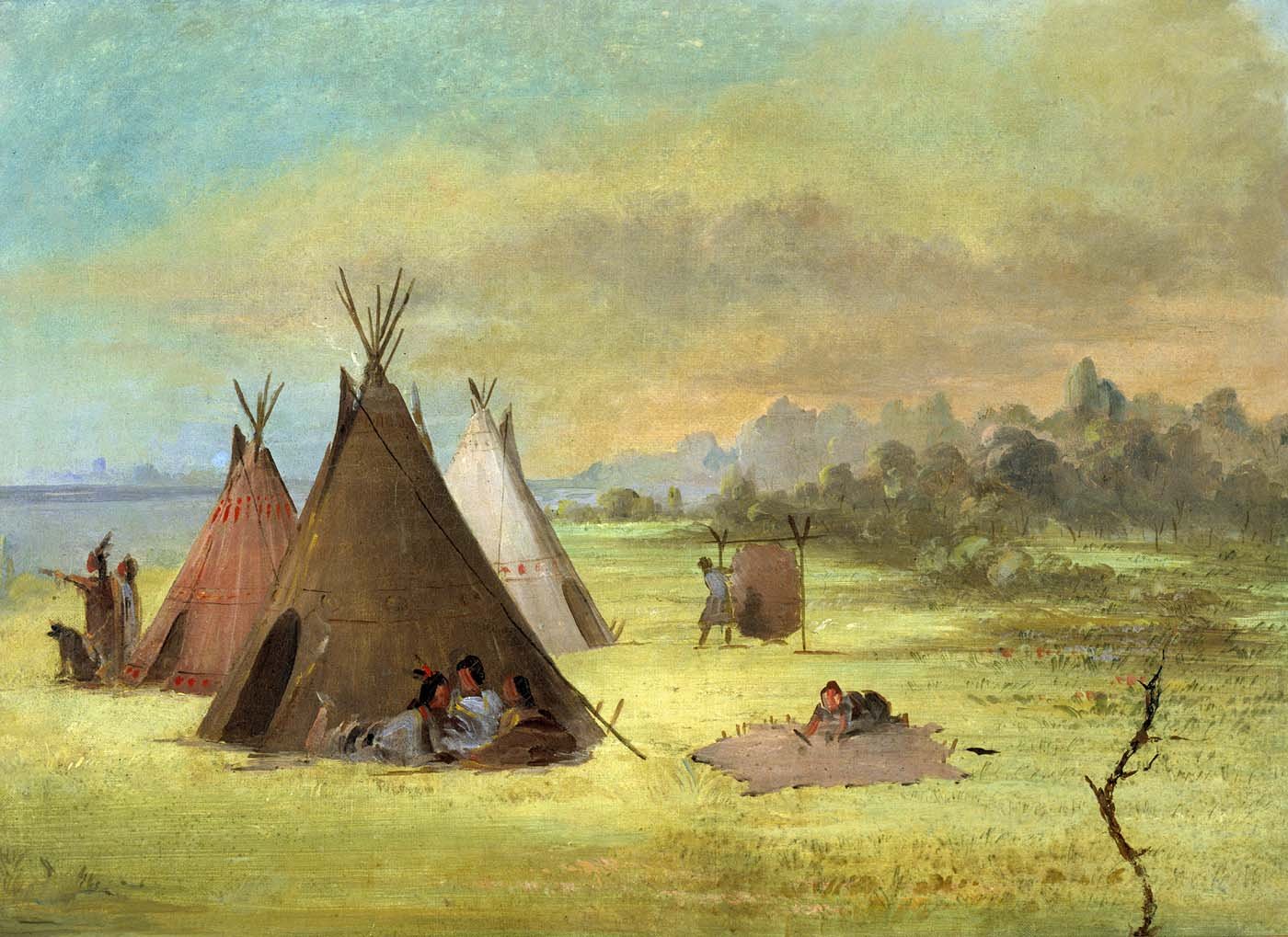 This is to give you a sense of how aware I am of Kiowa habits and behaviors, but not only Kiowa also Cherokee since I've had the fortunate circumstance of growing up within both cultures and moving back and forth between Lawton and Tahlequah in various forms throughout my life. These landscapes (Southern Plains and Ozark Hills) are not only imprinted in my memory, but my fiction as well.When this individual from Twitter mentioned "hyperlocal" as a description of my writing, I started to think about these nuanced cultural practices, behaviors, and perspectives, and how it was born from "writing what I know." And I think there can a tremendous benefit to this form of regionalism. What I do isn't any different in theory to Faulkner's depiction of the South during his time.Readers crave escapism. And at the onset of using a term like escapism there is an immediate interpretation of needing "to escape from reality" as a coping mechanism. But I would argue readers are more interested in engaging with creative work to find a reflection of themselves so as to examine their own presence on this planet. They are interested in growth, whether this is a conscious or subconscious effort is an argument for another nerdy post, but all in all readers are looking for "safe" ways to examine their own condition. It is through compare and contrast we find new ways to behave. Sometimes these new behaviors are better and sometimes they are destructive. But we will survive by any and all creative means, so I believe readers are subconsciously looking for validation and simultaneously seeking new ways of survival.The hyperlocal is a great way to find a place to escape, and to find a different culture to observe so as to better understand our own behavior. For me, this dynamic is on the surface. I love change, and stagnation is deadly. I want to become different. I want growth. But for others there may be a subconscious reason for engaging with the hyperlocal. The writing will resonate with them and they can't pinpoint why--just that there is something appealing about it.The means I use in which to tap into this dynamic? Is hyperlocal.
This is to give you a sense of how aware I am of Kiowa habits and behaviors, but not only Kiowa also Cherokee since I've had the fortunate circumstance of growing up within both cultures and moving back and forth between Lawton and Tahlequah in various forms throughout my life. These landscapes (Southern Plains and Ozark Hills) are not only imprinted in my memory, but my fiction as well.When this individual from Twitter mentioned "hyperlocal" as a description of my writing, I started to think about these nuanced cultural practices, behaviors, and perspectives, and how it was born from "writing what I know." And I think there can a tremendous benefit to this form of regionalism. What I do isn't any different in theory to Faulkner's depiction of the South during his time.Readers crave escapism. And at the onset of using a term like escapism there is an immediate interpretation of needing "to escape from reality" as a coping mechanism. But I would argue readers are more interested in engaging with creative work to find a reflection of themselves so as to examine their own presence on this planet. They are interested in growth, whether this is a conscious or subconscious effort is an argument for another nerdy post, but all in all readers are looking for "safe" ways to examine their own condition. It is through compare and contrast we find new ways to behave. Sometimes these new behaviors are better and sometimes they are destructive. But we will survive by any and all creative means, so I believe readers are subconsciously looking for validation and simultaneously seeking new ways of survival.The hyperlocal is a great way to find a place to escape, and to find a different culture to observe so as to better understand our own behavior. For me, this dynamic is on the surface. I love change, and stagnation is deadly. I want to become different. I want growth. But for others there may be a subconscious reason for engaging with the hyperlocal. The writing will resonate with them and they can't pinpoint why--just that there is something appealing about it.The means I use in which to tap into this dynamic? Is hyperlocal.
Support a Native owned Etsy shop, Allies United, where I offer unique merch for allies of social justice movements, like MMIW, Native Lives Matter and Black Lives Matter. Take a look inside my Etsy shop here: etsy.com/shop/AlliesUnited.
(Works Cited: Both images were borrowed from wikimedia)
Seeing through Layers like Blankets on a Cold Night
My father was am immigrant from Mexico. My mother a full blood Kiowa/Cherokee from Oklahoma. They worked the peanut and cotton fields when my sisters and I were young. I remember ducking the large rolling water sprayers in the fields; I remember the heat coming from the dirt onto my bare feet; and I remember living in abandoned farm houses in the Oklahoma fields. Let me tell you about cold nights. No, better yet, let me tell you about the warmth you can have from the thin layer of a blanket.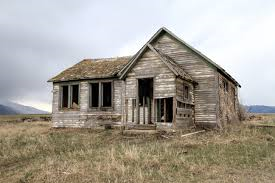 As I make progress through the revision stage of my novel, Uncle Called Him Spider, I visualize odd and peculiar moments in my life. Here I am thinking about point of view, analyzing the spaces between first person narrative and third person limited omniscience, and I start to make the comparison of that space to the thin layer of a blanket on a cold night. Then I remember the farm houses.Odd how the memory works.So a few days ago I was living through a fictional space in my mind where I envisioned someone asking me, "Why did you write Uncle Called Him Spider in third person limited omniscient instead of first person?" They would go onto explain how the two forms aren't very far apart structurally. So many great novels are written in the first person. Yes, I actually visualize conversations like this. And, yes, I'm only a breath away from insanity, but only the good writers are.
As I make progress through the revision stage of my novel, Uncle Called Him Spider, I visualize odd and peculiar moments in my life. Here I am thinking about point of view, analyzing the spaces between first person narrative and third person limited omniscience, and I start to make the comparison of that space to the thin layer of a blanket on a cold night. Then I remember the farm houses.Odd how the memory works.So a few days ago I was living through a fictional space in my mind where I envisioned someone asking me, "Why did you write Uncle Called Him Spider in third person limited omniscient instead of first person?" They would go onto explain how the two forms aren't very far apart structurally. So many great novels are written in the first person. Yes, I actually visualize conversations like this. And, yes, I'm only a breath away from insanity, but only the good writers are. It's a good question. I'm glad the fictive personality in my mind asked. Why third over first? I think it goes back to the blanket on the cold night. So what does first person perspective do? It pulls the reader in close. You are directly inside the narrator's mind and you are watching what the narrator watches. You only experience what the narrator feels. You are under the blanket.So you're going to argue third person limited does the same thing. But I'm going to disagree with you. It does put you, the reader, inside the main character's mind. Yes, you feel what she feels and you get to hear her thoughts. But there is one thing first person doesn't offer: Freedom.With just a thin layer of distance, third person limited omniscient gives the reader a power lost to the first person POV. Because you are subconsciously noticing the "he said, she said" aspect of the writing, you are then subconsciously implementing the "he said, she said" mentality. Meaning? You cast judgment more readily. You are less likely to identify with the main character and more likely to criticize her.
It's a good question. I'm glad the fictive personality in my mind asked. Why third over first? I think it goes back to the blanket on the cold night. So what does first person perspective do? It pulls the reader in close. You are directly inside the narrator's mind and you are watching what the narrator watches. You only experience what the narrator feels. You are under the blanket.So you're going to argue third person limited does the same thing. But I'm going to disagree with you. It does put you, the reader, inside the main character's mind. Yes, you feel what she feels and you get to hear her thoughts. But there is one thing first person doesn't offer: Freedom.With just a thin layer of distance, third person limited omniscient gives the reader a power lost to the first person POV. Because you are subconsciously noticing the "he said, she said" aspect of the writing, you are then subconsciously implementing the "he said, she said" mentality. Meaning? You cast judgment more readily. You are less likely to identify with the main character and more likely to criticize her.
"The omniscient narrator is a bizarre technique, when you think about it, and no one uses it much anymore. But for the novels I want to write, it's the only approach that makes sense to me." -- by Min Jin Lee
Why? It's space. Being on the outside of the blanket you still feel the cold night, while the main character is cozy under the blanket. There's enough distance to analyze and criticize situations as the main character moves through the storyline. In essence, it empowers the reader to make their own conclusions without the main character trying to convince them otherwise.I'm going to take this a little deeper--just for food for thought. I think it may be an issue of control. If an author wants you to think a certain way about a character she will do anything and everything to persuade you, like using first person narration. Now, don't get upset at me for making this claim. If you go read the three free short stories on my website, you'll find three first person short stories. I write first person. But as I think about the novel I'm writing I can't help but wonder how much of it has to do with authorial control over the reader. Maybe I'm in a space of letting go, ready to give readers their freedom so I can have my own. Or...maybe I think way too much about this shit. :)
Support a Native owned Etsy shop, Allies United, where I offer unique merch for allies of social justice movements, like MMIW, Native Lives Matter and Black Lives Matter. Take a look inside my Etsy shop here: etsy.com/shop/AlliesUnited.
(The images used in this post were borrowed from Wikimedia and Wikipedia)
(Images were borrowed from pexels.com and terrain.org)










